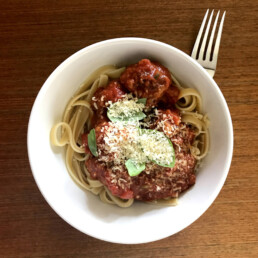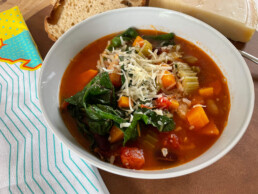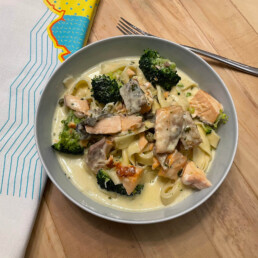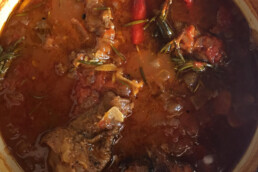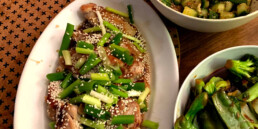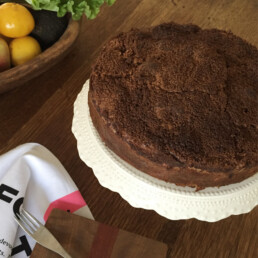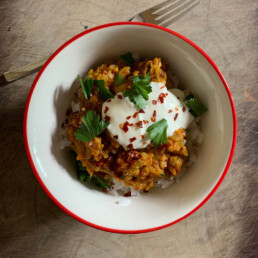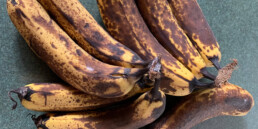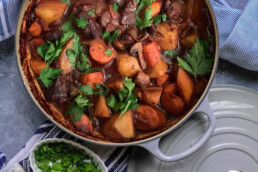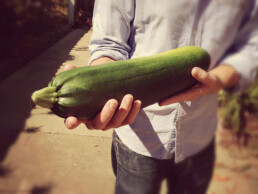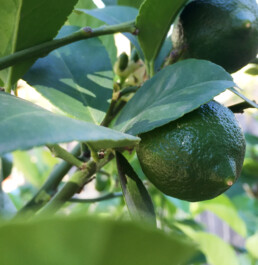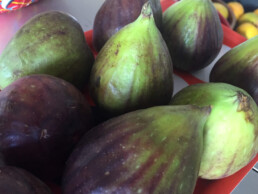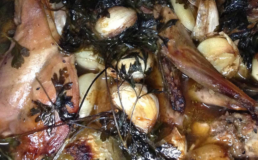Meat Balls Galore
WHAT A LOAD OF (MEAT) BALLS
Everyone has their own special recipe, right?
Small delicious balls of goodness simmering in a rich tomato sauce.
Every mouthful a flavour sensation, a morish pleasure, a bringer of smiles and happy full bellies.
Prep Time: 25 minutes | Cook Time: 30-40 minutes
Ingredients
–
For the meatballs
500 g minced pork
500g lean minced beef
1 large red onion finely chopped
2 cloves garlic finely chopped
Dried oregano
Fresh thyme
Plenty of salt & pepper
Breadcrumbs
1 egg to combine
–
For the sauce
2 tbsp olive oil
2 cloves of garlic finely chopped
1 small brown onion finely chopped
4 rashers bacon or pancetta finely chopped
2 x 400 g tins organic whole tomatoes
2 tbsp red wine vinegar
1/2 tsp sugar
1/2 tsp salt
Big handful of fresh basil to serve
Spaghetti or Fettuccine to serve
Gratted parmesan to serve
Method
In a big bowl combine all of the ingredients for the meatball mix apart from the breadcrumbs. Get in and use your hands and the breadcrumbs slowly. The consistency needs to be slightly sticky. Test your mixture for taste – fry off a little bit and allow to cool. Adjust seasoning to the mixture to taste.
In your hand roll a good tablespoon of mixture into a little ball. Ideally about 2 bite sizes. Repeat. This mix makes about 60 balls!! In a large fry pan on a medium heat add a good gulp of olive oil and gently fry your meatballs in batches of 10-15. They take about 5-6 mins brown all over. Nice too when they stick a bit to the pan. Set these aside and now crack on with your sauce.
The sauce. In a large deep pan (you’ll be adding the meatballs to this) fry off the garlic, add the onions and cook on a medium heat until the onions soften and become translucent. Add the tomatoes, stirring and turn the heat down to simmer. Add the red wine vinegar, sugar, herbs and season. Allow to simmer away and reduce down. Add a little water if the sauce becomes too thick. Stir in the meatballs carefully to the sauce, batch by batch, the sauce should be bubbling gently and once the meatballs are in the sauce allow to simmer gently for a few more minutes. Then take off the heat. Prepare your pasta. Serve away…
Don't push my button
Why do we love pushing buttons?
Well, there are lots of reasons — historically buttons were new technologies. Amazing to consider that ‘back in the day’ we had to learn how to use buttons but once we did there was no stopping us.
If we unpack the functionality behind the button of course we reveal that there’s always a motivation. An action, a call to action in the World Wide Web… that has an outcome. When the function is clear it’s like turning a light on, or closing the elevator door. We’re in control, we like being in control. We see the effect of our action. This basic functionality is clear and predictable (most of the time).
ACTION = REWARD
However, this changes somewhat when surfing the web or your favourite app. The button has the ability to take us on a journey… especially if that button incentivises the user with a promise of, er showing you something exciting or of value… herein lies the trick of the naughty hackers.
Whether its supporting your friend’s endeavours or applying a discount code we are all, sometimes, far too quick get involved.
So clearly we are all vulnerable to our own judgment (or lack of in the throes of an un- caffeinated early morning) so I’ve decided to create a little experiment right here for you to try.
The idea behind this leads into another very engaging conversation around UX/UI button design — a can of worms we’ll open another time — but for now here are 3 buttons.
Press a button
Or will you just play it safe and not press any?
And what will influence your decision?
Tempted?
Super Zuppa
EAT LIKE A PEASANT AND FART LIKE NOBILITY
The soup to make when a friend gives you silverbeet.
This is pretty much an Italian bean soup that’s a little watered down (lol). I do think Nigel Slater’s version, with parmesan rind and crostini, is the bomb and there are countless versions of this soup with kale and other ingredients — but this is the Chops For Tea version without the cheese, although you may well be cutting some… Its heartfelt goodness will sound aloud, eat with close friends.
Prep Time: 15 minutes | Cook Time: 25 minutes
Ingredients
4 tablespoons extra-virgin olive oil
3 garlic smashed
1 large onion chopped
4 carrots peeled and chopped
3 celery stalks chopped
1/4 teaspoon chilli flakes
1 generous teaspoon finely chopped fresh (or dried) rosemary
1 x 400 g tomatoes
1 cup passata
3 tbsp tomato puree
3 x 400 g mixed beans — cannellini, red kidney, butter beans (you name it) rinsed & drained
1 bunch Silverbeet with stems and ribs discarded, leaves chopped
2 bay leaves
Salt to taste
Freshly ground pepper
Serve with
1/2 cup grated Parmigiano Reggiano cheese
Fresh sourdough with plenty of unsalted butter of course
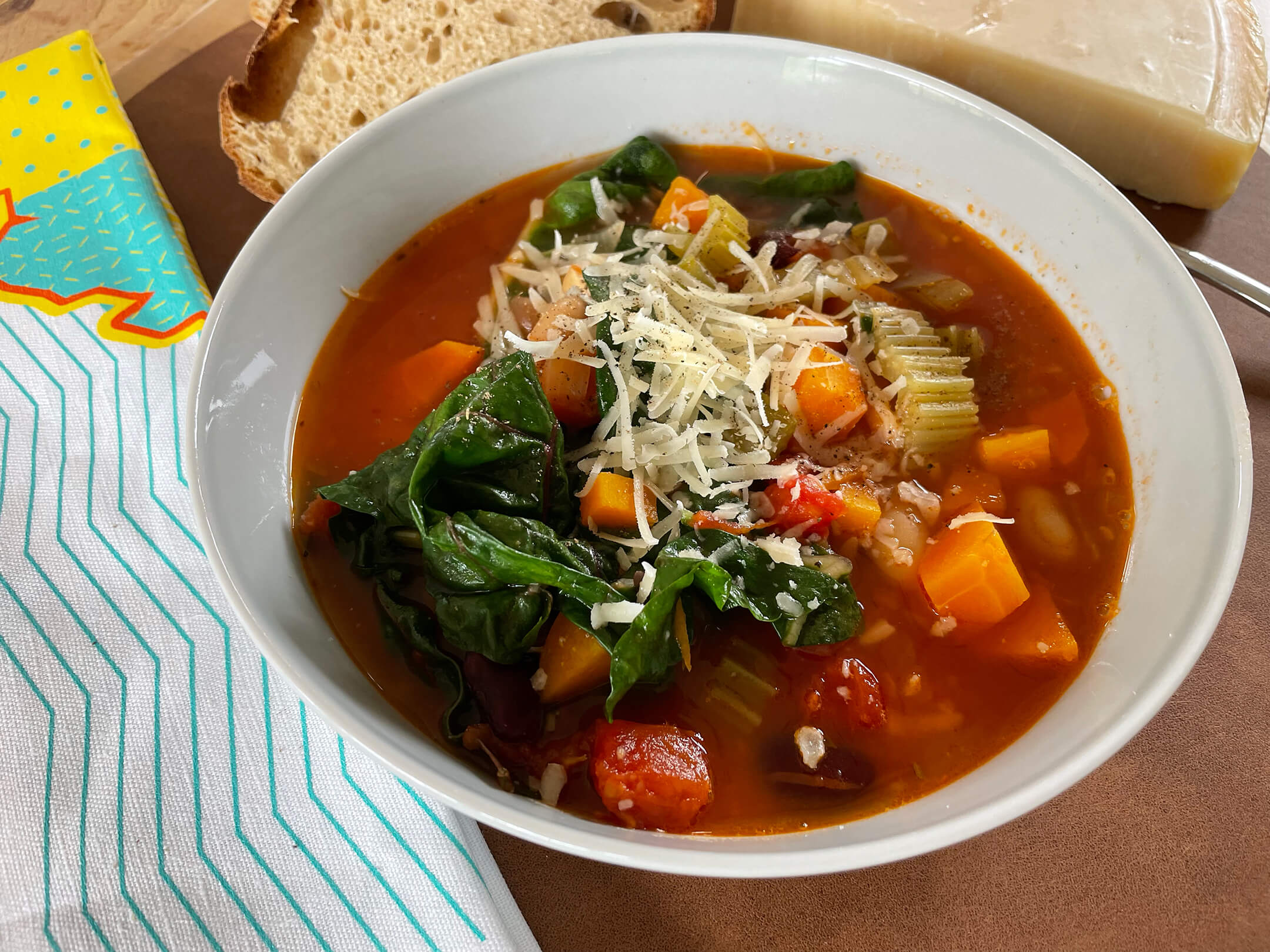
Method
In a large pot, heat the oil add the garlic and soften the onion.
Add the carrots, celery and chilli flakes, with plenty of salt & black pepper. Continue to soften ensures nothing sticks to the pan. Once the veg begins to soften too add the rosemary, tomatoes and passata.
Stir away, then add the puree and tins of mixed beans (remember to rinse the beans).
Add the bay leaves and simmer for a few mins. Add the silverbeet and cook until the leaves wilt – DO NOT OVERCOOK — carrots should still have some bite.
Season again and serve with freshly grated parmissan.
Dreamy Creamy Salmon Linguine
FRIDAY NIGHT HEAVEN
Quick, delicious and full of smiles.
First discovered on a Friday at 8.30 pm after work drinks.
This rich, dreamy, creamy treat is best enjoyed with a glass of chilled white. It’s quick and tastes bloody awesome any day (or night) of the week.
Prep Time: 10 minutes | Cook Time: 20 minutes
Ingredients
400g cooked salmon fillet, flaked or roughly chopped
250g uncooked linguine (tagliatelle works well too)
1 bunch broccoli, cut into little florets
2 tbsp butter
2 garlic cloves, minced
2 cups thickened or double cream
2 tbsp lemon juice
1/4 tsp salt
1/4 tsp black pepper
1 cup grated Parmesan cheese
3 tbsp minced fresh basil or 1 tbs dried basil (basil paste works a treat here)
2 tbsp capers
2 tsp lemon zest
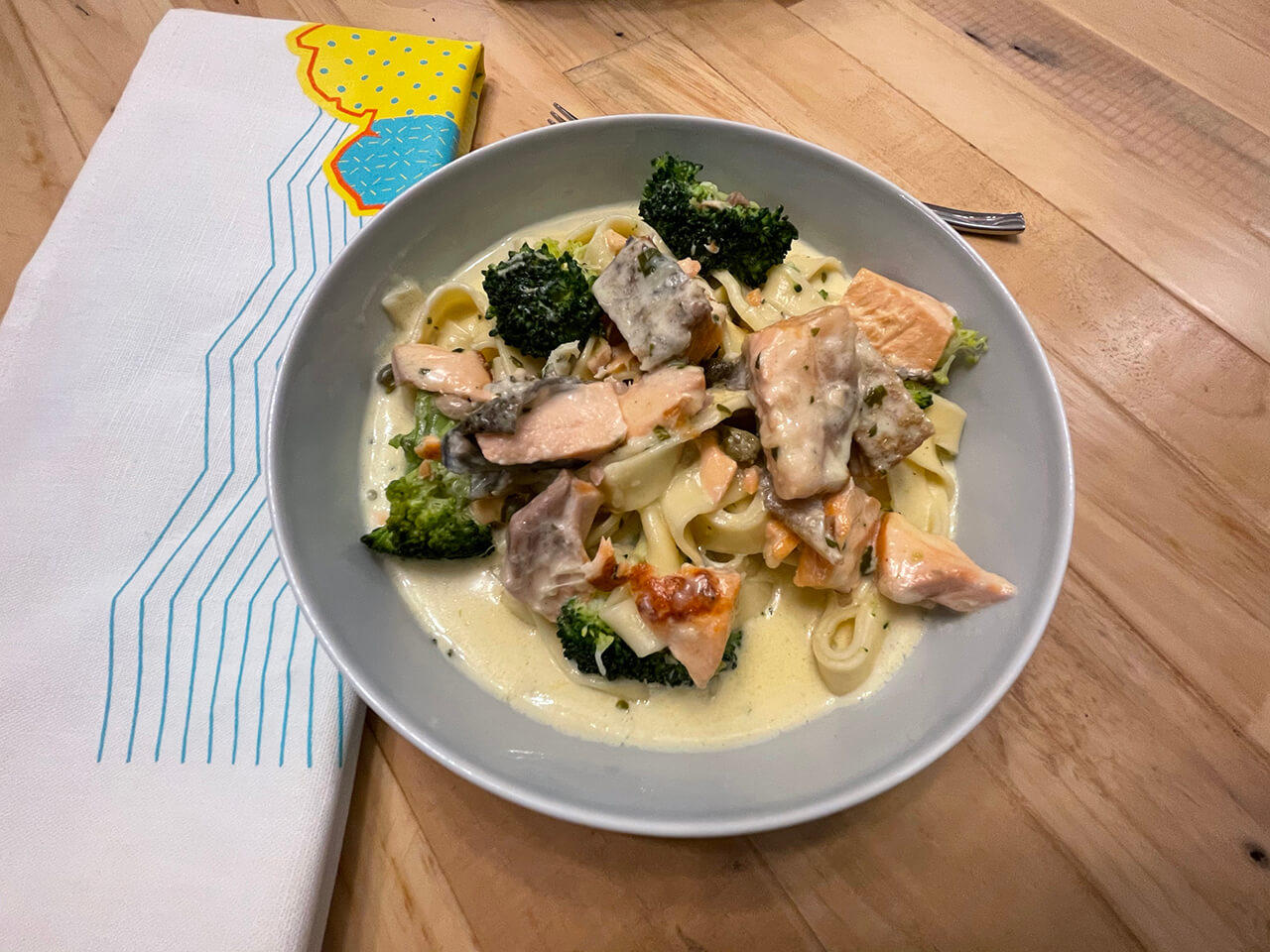
Method
Pan fry the salmon fillets. I love keeping the skin on!
Cook linguine according to package directions, adding broccoli during the last 5 minutes of cooking.
Meanwhile, in a large skillet, heat butter over medium heat. Add garlic; cook and stir 1 minute. Stir in cream and lemon juice. Bring to a boil. Reduce heat; simmer, uncovered, 2-3 minutes or until slightly thickened, stirring constantly.
Add salmon, salt and pepper; heat through.
Drain linguine and broccoli; add to skillet. Stir in cheese, basil, capers and lemon zest.
The Magic Design Pill
OUR DESIGN PROCESS
It’s every designer or client’s dream. A Magic Design Pill, that when consumed (let’s not worry about the details here) enables the taker to produce solutions to any design problem, instantly.
Or could this be a nightmare?
Thankfully there is no Magic Design Pill. I’ve even checked on the interwebs but imagine if such a pill did exist. How would it work?
Do we just pop one — for a perfect 1 time only pilled-up solution? What happens if we pop 2? 2 perfect solutions? And is that taken with water and do we still need to do the actual work? Does the pill taker drop into a deep state of (creative) concentration and start auto-creating?
Or do we just pop the pill, from the designer blister pack, add water and watch it miraculously grow? Ready for us to harvest — ‘picking’ the ideas we love the best? How do we create vector artwork from that?
Or is this a pill administered by our Macs? “Siri — can you please just put together that social media campaign for me, please. Yes, you’ve had 3 pills this morning you greedy little ai…”
So ideas growing inside our computers — like a virus… (yeah surely not).
Really? What could possibly replace the thrill of the creative journey?
I posit that if such a pill did exist that we wouldn’t be queuing up to take it… (well maybe you gotta try it once). But think about the deep desk-based research (Covid days), workshopping with clients, the mapping of competitive landscapes, defining personas, the craft of pulling a mood board together. And that’s all before you’ve even had a thought about a creative concept. That all gets skipped.
There is real magic in what designers do. A creative process that helps to give meaning and structure to what we do to enable us to bring ideas to life. The process is the magic pill, the vehicle that enables us to journey down a well-trodden path with every new project or client allowing us to see the path in a new and exciting way.

The creative journey, inside our creative process.

Research
The foundation for any creative work.
Get your thinking right and the rest will fall into place. For brand identity, a brand workshop is an invaluable & revealing discovery tool.
Concept
Exploring the possibilities.
Create visual expressions exploring themes from your research. 3 concept directions offer an array of ideas every good project deserves.
Development
Focus & refinement.
Developing a concept, testing assumptions and pushing design boundaries. Exploring imagery
and relationships between colour, shape & type.
Application
Say it like you mean it.
Roll out design collateral with a bold conviction that honours your thinking & research.
Winter Warming Lamb Shanks
SEASONED BLEATINGS
Tender, succulent lamb shanks, fit for anyone’s birthday.
On a bed mash, to bring a smile to your face and joy to your belly. All hail the messiah (Jamie Oliver).
PLEASE NOTE — if meat is not your thing, remove the lamb component from this dish.
Enjoy 😉
Ingredients
2-3 smoked ancho chillies (use 1 tsp chipotle chilli powder if you can’t get ancho chillies)
1 large handful of raisins
285 ml unsweetened apple juice
4 lamb shanks
Olive oil
3 red onions
8 cloves of garlic
2-3 fresh red chillies
1 heaped teaspoon smoked paprika
3 fresh bay leaves
2-4 sprigs of fresh rosemary
1 x 400 g tin of plum tomatoes
750 ml organic chicken stock, optional
Red Wine Vinegar
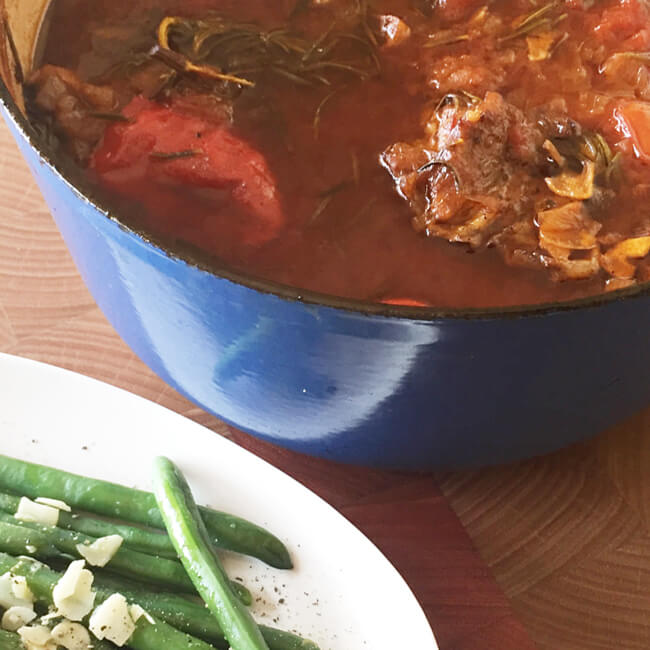
Method
Preheat the oven‚ as high as it will go.
Put the dried chillies, raisins and apple juice in a bowl, then set aside.
Put the lamb shanks in a roasting tray and rub all over with oil, sea salt and black pepper. Put them in the oven for 20 minutes.
As they are browning, peel and finely chop the onions, peel and finely slice the garlic, then halve and deseed the chillies.
Grab a casserole pan that will fit the shanks quite snugly ‚about 24cm in diameter and 10cm deep. Put it on a medium heat and add a lug of olive oil, the onions, garlic, fresh chilli, smoked paprika, bay leaves and rosemary. Leave to sweat for about 10 minutes.
Once the onions have softened, put the re-hydrated chillies and raisins into a food processor or liquidiser, along with any leftover apple juice, then blitz (feel free to sneak in a swig of red wine or bourbon here!) until you‚ have got a paste. Stir this into your onions.
Take your shanks out of the oven and turn the temperature down to 140ºC.
Add the shanks to the casserole pan along with your tinned tomatoes and stock (if using) or equal amounts of water
Stir everything together, cover and put in the oven to stew for 2 hours 30 minutes to 3 hours, or until the meat is falling off the bone and the sauce is thick, topping up with water or stock as you go. Take it out of the oven, have a taste and season with salt and pepper and a dash of vinegar.
Serve with steamed greens, mash, flatbreads, or whatever you fancy really!
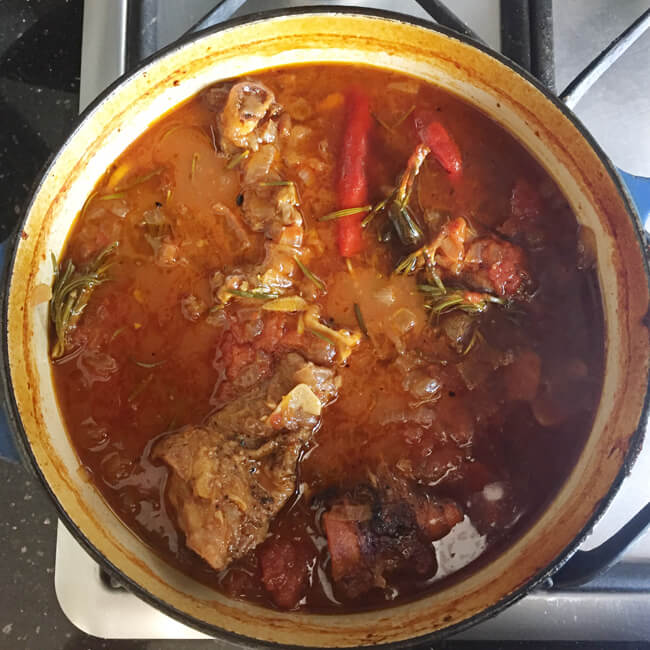
Love Where You Live
DESIGNER POSTCODES
From 0200 to 9944 there are around 3280 postcodes covering over 15,000 cities, towns, townships and areas.
Embrace its familiarity, rejoice in your PJs, walk proudly around the streets of your neighbourhood (wearing your mask). Let’s celebrate home sweet home as, without a doubt, the place you live and by default its postcode are undeniably a little part of you.
I love my current postcode 3450, the sequence of these numbers is especially pleasing but I also love 2680, 3121 & 3122 the other places I have lived. However, I feel there is beauty in every postcode.
Inspired by a love for pattern, shape, colour and administrative boundaries I’ve created a design system that brings these passions together.
Introducing the Candy Range.

3000 — Melbourne, VIC

Each number is featured in one of 4 hero colours. Mixing and matching colours create endless combinations (almost).

2680 — Griffith, NSW

2481 — Byron Bay, NSW

0872 — Uluru, NT
The current postcode system was introduced to Australia in 1967. The 4 digits represent sorting information often linked with one area. Larger cities and town mostly end with a zero.

2484 — Murwillumbah, NSW

6725 — Broome, WA

3450 — Castlemaine, VIC
You’re invited to build your own postcode choosing colour options for each number. Sadly we are not able to show you a live preview, as this is still in development, but we will send you a proof via email very quickly — with an option to see an alternative if you choose — once you’ve made a purchase.
Currently, A4 prints are offered in the block format only.
Salmon Teriyaki with Asian Greens
YOUR DINNER GUESTS WILL LOVE YOU
But don’t confuse the salmon & chicken.
We found this to be a perfect midweek lockdown treat. Works with salmon or chicken and with a side dish of Bang Bang Cucumber. Served with jasmine rice and stir-fried Asian greens.
Ingredients
500 g of Salmon fillet (skin on) cut into 4 pieces
or 500 g (roughly 4) Chicken Thighs (skin on)
For the teriyaki source
1 tbsp Rice Wine or Mirrin
1 tbsp Brown Sugar or Honey
2 Garlic cloves — minced or finely grated
2 tbsp Ginger — minced or finely grated
1/4 Cup of Light Soy Sauce
1 tbsp Cornstarch + 1 tbsp cold water to thicken up the sauce (mix first)
Top with
Spring Onion — sliced on the diagonal
Sesame seeds — go for it
Asian Greens
use Bunch of Bok Choy
Pak Choi
Choy sum
add Snow Peas for extra crunch and flavour
1 clove of garlic (finely chopped or grated)
1 cm of peeled grated ginger
Good dollop of oyster sauce
Splash of fish sauce
Method
TERIYAKI SAUCE
Make the sauce first — half is used to marinade the salmon or chicken.
Combine all of the ingredients except the cornstarch mix in a bowl. Use half for the marinade — set aside the other half to combine with the cornstarch mix. When ready, in a small saucepan, on a low heat, stir the mix until it begins to thicken, then pour your teriyaki sauce over the salmon or chicken. It’s that simple… Add the chopped spring onion and liberally sprinkle with sesame seeds.
TERIYAKI SALMON OR CHICKEN
Place the salmon or chicken fillets in a bowl and marinate for 30 minutes (note that we generally chop the chicken thigh fillets into 3 pieces).
When you are ready to cook heat a little oil in a large skillet (you don’t need much oil). Add salmon filets my pan takes up to 4, don’t overcrowd! Cook for 3 to 4 minutes on each side, looking for a nice colour, start with the skin side down and get a little crispy. Meanwhile, heat the reserved marinade in the saucepan and bring to a simmer. Add cornstarch and water to a small bowl and whisk to combine. Slowly whisk in the cornstarch mixture to the marinade and simmer until thickened. Serve immediately with the teriyaki sauce drizzled on top as well as spring onions and sesame seeds.
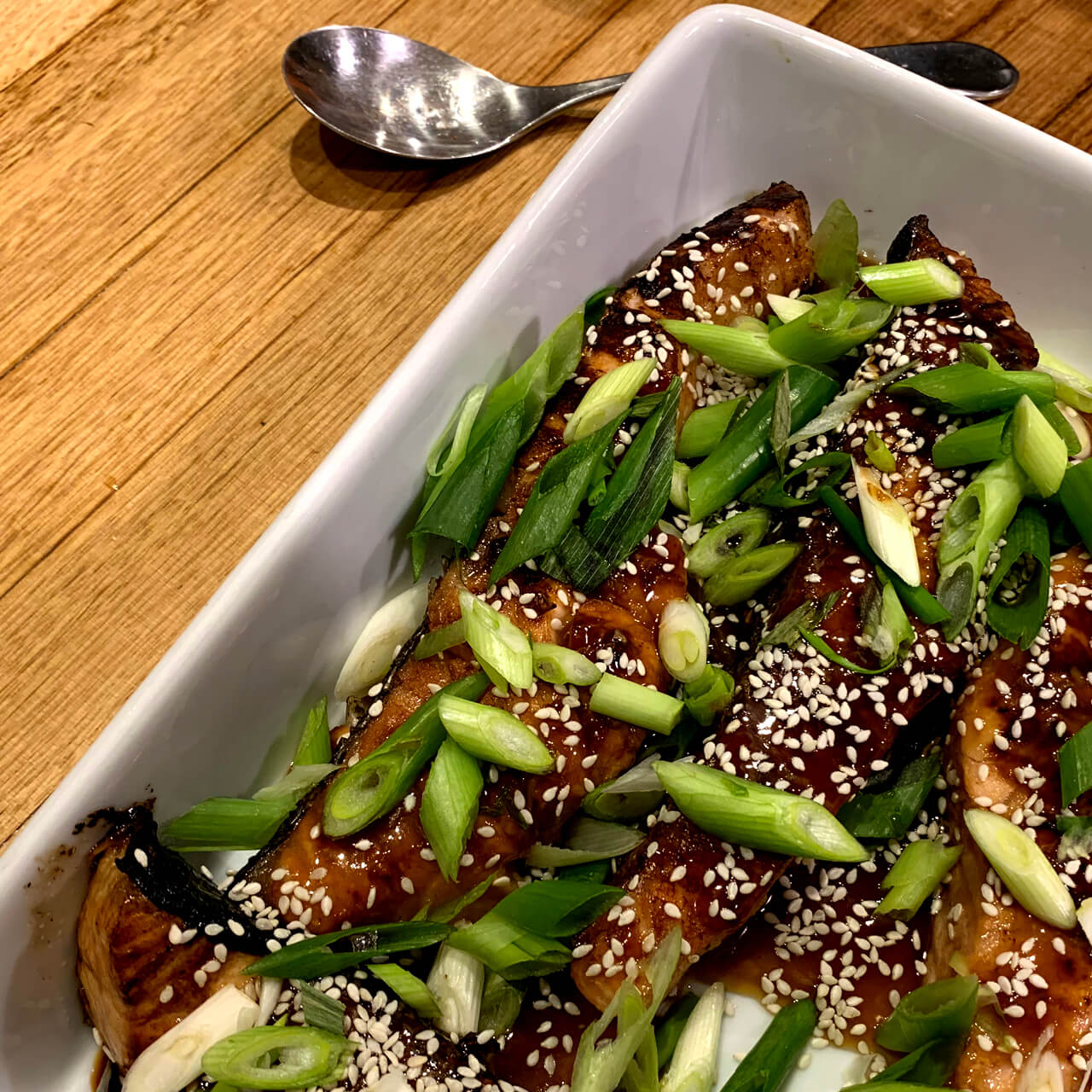 Salmon, not chicken
Salmon, not chicken
The Best Rhubarb Cake Ever
BAROSSA RHUBARB CAKE
This cake is the bomb.
A while ago 2 dear friends in Castlemaine made claims to be the originators of this recipe but after digging around I discovered the real source. With thanks to Katie Quinn Davies, I’m now able to claim this as my own. Oh and be careful who you share this with, you’ll coming back for seconds, third & fourths.
Ingredients
60g butter
380g brown sugar
2 free-range eggs
1 tsp vanilla
300g plain flour
1 tsp bicarb of soda
1 tsp cinnamon
500g rhubarb cut into 2cm pieces
Grated rind of 1 lemon
250ml (1 cup) sour cream
Cake Topping
80g brown sugar
1 tsp cinnamon
Method
Beat butter with brown sugar. Add eggs & vanilla. Stir in sifted flour, soda & cinnamon. Add rhubarb, rind & sour cream. Stir with wooden spoon.
Spoon into a buttered and baking paper lined 22cm cake tin.
Sprinkle with topping.
Bake in a preheated 180 C oven for 50 to 60 minutes (I find it takes a bit more than 60 mins).
A to Z — the prints are coming
ABOUT TIME
Absolutely thrilled to announce that prints from my 36 days of type series for 2020 will soon be available to purchase through the Chops Shop.
Initially A4 & A3 letters & numerals with larger prints plus the whole alphabet on the way… We are also looking to create bespoke words & commissions to order.






More Dahling?
DAHL, I LOVE YOU
Quick, easy, really tasty and sure winner with your non-meat eating friends.
Every now and then you stumble upon a recipe that fills you heart (and belly) with joy.
Prep Time: 20 minutes | Cook Time: 45-55 minutes
Ingredients
2 tbsp butter, ghee or coconut oil
1 onion/s (large) peeled and diced
3 clove/s garlic -peeled and sliced or crushed
3 cm ginger root -peeled and finely diced
1 carrot/s (large) grated
1 zucchini/s -grated
1 tsp cumin seeds
1 tsp ground cumin
1 tsp ground coriander
2 tsp mustard seeds
2 tsp garam masala
1 tsp ground turmeric
350 g roma tomatoe/s -roughly chopped or 1 can of tinned tomatoes
200 g split red lentils -dried (1 cup)
400 ml coconut milk -or cream (the cream gives a richer, creamier consistency)
350 g chicken stock or bone broth – or vegetable stock or water
3 tbsp almond meal
Chilli flakes -to taste
Sea salt -a good pinch (this really brings out the flavour)
Ground black pepper -to taste
1 lime/s -juice and zest to finish
1 bunch fresh coriander leaves -roughly chopped
Optional-
6 fresh curry leaves – optional but yummy
Method
In a medium sized pot, over a low to moderate heat, add the butter, ghee or coconut oil. Sauté the onion, garlic, ginger and spices for two minutes or so.
Add the grated carrot, zucchini, tomatoes, lentils, coconut milk, water and almond meal. Season well, stir and leave to simmer for 15 to 20 minutes or until the lentils are cooked and most of the moisture is absorbed.
Finish with coriander leaves and lime. Season again if necessary (sea salt lifts the flavour in this so make sure you add it).
Serve with basmati rice and some fresh roti bread. I love to add plenty of chilli flakes for an extra hit, and the kids love a dollop of greek yoghurt on top too.
Going Bananas
THE KING OF COMFORT CAKES
What to do when bananas turn bad… we deliberately buy extra bananas so we can make this cake guilt free. Based on an original Edmonds Cookbook recipe, tweaked just a little over the years, the additional of dark chocolate chips a must. This basic mix is really versatile and over the years I’ve added dates, walnuts and even added cocoa powder for an indulgent chocolate hit.
This is a staple in our house. Kids love it for lunch and it’s also a fab week night dessert — heated up a little and served with vanilla ice cream.
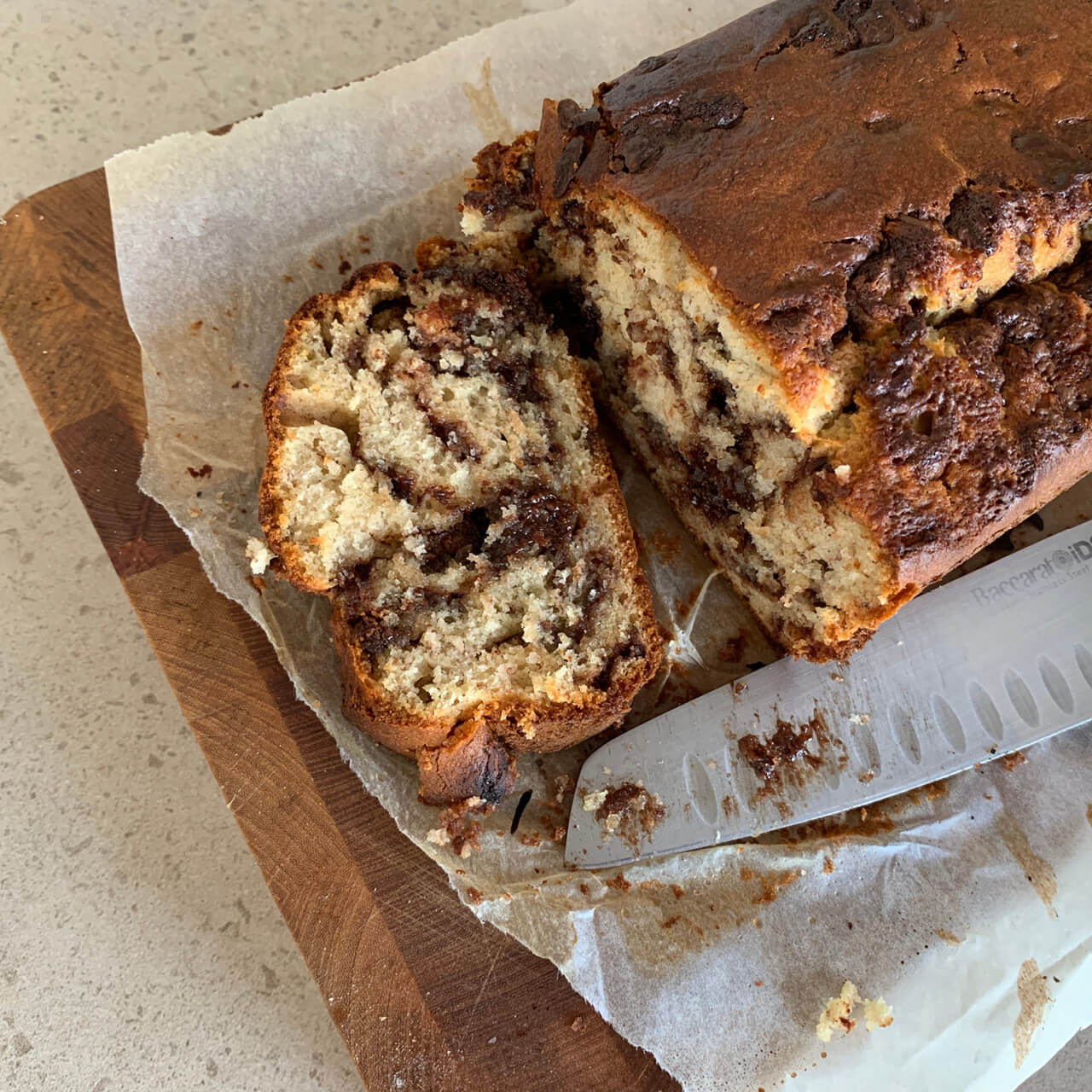
Ingredients
1 3/4 cups self raising flour
1/4 tsp baking soda (can use straight bi-carb)
1/4 tsp salt
1/2 cup caster sugar (try with brown sugar too)
1/2 cup of dark chocolate chips, or chopped dates or walnuts (all optional)
2 eggs
1/4 cup of milk
75 g melter butter — make sure it cools a little before adding
1 cup of mashed banana (that’s about 3 medium sized)
Method
In a mixing bowl mash the banana. Add the milk, melted butter (that you cool a little) and the eggs. Stir it all up.
In a separate bowl (I use the bowl from the Kitchen Aid) sift the flour and add the rest of the dry ingredients. Add the wet ingredients to the dry, mixing well until just combined — at this point add in chocolate chips, dates or nuts.
Mix again and pour into a greased and lined load tin.
Bake at 180 ºC for 45-55 mins. Leave in the tin for 10 mins before turning onto a wire rack to cool.
TIP: Use a skewer to check the cake is cooked. If it come out clean you’re good to go. Cover with foil if it needs cooking longer and you don’t want the top to burn 😉
How to waste time effectively
36 DAYS OF TYPE
An Instagram challenge —
I’m not as social (on social media) as I’d like to be because, generally speaking, I’m too busy helping my clients with their social stuff.
But once in a while it’s really important to do something that invigorates the creative within. Especially in a world where we can often get lost in our client project work with the constraints of a commercial world.
For the uninitiated, 36 Days of Type, now in its 7th year, starts in May when word gets put out and creatives from around the world embark on an often perilous, definitely time sucking, but ultimately rewarding journey — to imagine, create and share the weird, the wonderful and maybe even conventional typographic adventures & explorations.
Here are some of my thoughts on my first experience and why I’ll relish doing it all again next year.

It’s as easy as A, B ,C… or is it?
 eye eye — this was the first letter I submitted 🙂
eye eye — this was the first letter I submitted 🙂
Let’s start at the beginning.
Well, not quite… You see I missed the start ;( The letter ‘I’ was actually my first submission on day 9. And so what Inspired me? Well as mentioned I generally shy away from these types of challenges as it’s sometimes hard to make time for this kind of, let’s face it, indulgent activity. It then occurred to me that I might adapt work created for clients, repurpose and explore ideas that never saw the light of day. And so ‘I’ was inspired by the identity work I completed for Book Ink Publishing. At some point I’ll share this lovely little identity project but you can see the logo here. (You’ll need to scroll down to see it)

D, E & F followed on from A, B & C… naturally.
I was keen to keep these letterforms simple and work in with the grid that I had established. These letters were created after the challenge had officially finished and the creative direction for my set of letters had emerged and evolved.

G & H were the last 2 letters completed.
G & H were like visiting old friends.
Both of these letters picked up on themes already visited. The overall look for G was inspired by S — I wanted to play further with the starburst idea. H was designed to link back to the start with ‘I’ and work nicely with J. ‘I’ as mentioned was adapted from client work. I loved the simplify and the ‘all seeing nature’ of the dot. And as this was the first letter I completed this was the catalyst for everything that followed…
J, K, L, M, N, O
I got very excited.
As a creative once you latch onto an idea it’s a joy to roll with, play with, become best friends. The beauty of this challenge is there are no rules, anything goes — it’s a platform for pure creative expression — even limitless, the inspiration for my letter L………..




P, Q, R, S, T, U, V, W, X, Y, Z, 0
I couldn’t help myself with P 🙂
Conceptually my letter Q work a treat (I expected you see the Queuing sysyem I installed here 😉 My ‘R’ is adapted from an Identity I created for Ben Rousseau, a clever product & lighting designer now based in LA. S — see below…
T was simple, gain playign with the whole square tile – which I broke down into 3rds here. I love the shape of U and the negative space in the background. V and W are possibley my least favourite examples… V reminds me of a car badge — and W wlist I love the idea of the window intro the world it just isn’t quite right for me… X is a reprise of an old experiment I did with animated gifs and Y was a sunny disposiotion. Z was clever in a repeat print kind-a-way. As for 0 (zero….oooo) yeah, tied to relive the glories of ‘O’ but again I feel this missed the mark.



The sweet ‘S’ of success
Exploring variations on a theme. Once you sssstart… I was simple looking for seventies styling inspiration and I actually found it in an old copy of George Orwell’s 1984…
1, 2, 3, 4, 5, 6, 7, 8, 9
And so the numerals came bounding along
For all of the numbers I used a 6 x 6 grid (36 sqaures), placing the number within the central 16 squares… this becomes very apparent by the time we get to number nine. Here’s the inspiration for each number…
#1 Late night TV test card from the future
#2 Fruit label inspired (it was the starting point)
#3 Carnival, display font
#4 Woven textiles
#5 Inspired by the letter J… once created it remined my of the Pixies cover artwork for Doolittle – anyone see that reference? – maybe just the gold or me 😉
#6 Summertime
#7 Babe Rainbow and record sleeves, or maybe plasticine ;0
#8 One of my favourites. We could call it the Melbourne 8, the city of facades (literally cladding) I love the way the tones seem to shift and create movement.
And so we get to #9, a super play on #8 really and striking in its own right, this inspired the letters C, D, E & F… the shape of things to come.



You got my number?
Beef Stew with Carrots & Potatoes
A WARMING LATE WINTER STEW
This is pretty much Beef Bourguignon and it’s of course a classic, a bloody tasty — not for vegetarians — one pot meal.
Ingredients
1.25 kg gravy beef (chuck steak)cut into small chunks
2 tsp salt
3 tbsp olive oil
2 Large brown onions (cut into 2 cm chunks)
7 Cloves garlic (peeled and smashed)
2 tbsp balsamic vinegar
1.5 tbsp tomato pureé
1/4 cup Plain flour
2 cups red wine (Shiraz works but Burgundy or Pinot Noir maybe better!)
2 cups beef stock
2 cups water
1 bay leaf
1/2 tsp dried thyme
1.5 tsp sugar
4 large carrots, peeled and cut into 2 cm chunks on a diagonal
500 g potatoes chuck or (chats cut in half)
Fresh chopped parsley, for serving (optional)
Method
Preheat the oven to 160º C and set a rack in the lower middle position.
Pat the beef dry and season with the salt and pepper. In a large Dutch oven or heavy soup pot, heat 1 tablespoon of the olive oil over medium-high heat until hot and shimmering. Brown the meat in 3 batches, turning with tongs, for about 5 minutes per batch; add one tablespoon more oil for each batch. (To sear the meat properly, do not crowd the pan and let the meat develop a nice brown crust before turning with tongs.) Transfer the meat to a large plate and set aside.
Add the onions, garlic and balsamic vinegar; cook, stirring with a wooden spoon and scraping the brown bits from bottom of the pan, for about 5 minutes.
Add the tomato paste and cook for a minute more. Add the beef with its juices back to the pan and sprinkle with the flour. Stir with wooden spoon until the flour is dissolved, 1 to 2 minutes.
Add the wine, beef broth, water, bay leaf, thyme, and sugar. Stir with a wooden spoon to loosen any brown bits from the bottom of the pan and bring to a boil. Cover the pot with a lid, transfer to the preheated oven, and braise for 2 hours.
Remove the pot from the oven and add the carrots and potatoes. Cover and place back in oven for about an hour more, or until the vegetables are cooked, the broth is thickened, and the meat is tender. Fish out the bay leaf and discard, then taste and adjust seasoning, if necessary.
Serve the stew warm. Clearly the stew improves in flavour if served the following day. Do garnish with fresh parsley.
The Underrated Art of Procrastination — Part Unfinished
PART UNFINISHED
An exciting conclusion coming soon!
Well what did you expect?
The truth is I wrote the conclusion to this little series of posts over a year ago — whilst travelling at high speed on a train to Shanghai. Sadly, I managed to ‘mislay’ the file – don’t ask – and I’ve not got around to rewriting. Although it probably needing rewriting anyway.
For now I do include some picture of the train I was on. And I may even get around to writing more about a life affirming work related trip to China I made last year…

Jinan — Nanjing — Shanghai



Jinan, cultural immersion

Mr. Chops makes some friends at the International Renewables Energy Convention, Jinan
The Underrated Art of Procrastination — Part Two
YELLOW
Note — make yourself comfortable.
Another coffee, glass of red? Have you eaten? Kinda hungry? What’s for dinner tonight? Lunchtime. Bugger — does that chicken go out of date today? Who’s texting now… oh yes, oops, forgot about that.
Right, better nip to the supermarket now. Quick email first‚ placate client — they’ll have the changes this arvo. What’s this playing… hey, love this choon … … … … … … I better get to the shop before lunch.
In this post I explore the notion that metaphorical planetary alignment is essential for a procrastinator to finally get on with it …

It’s taken me a little longer to get in the zone to write this instalment. Principally because I’ve not taken my own best advice — I failed to effectively plan.
As a procrastinator of some years (probably most of my life) I seem to like avoiding the tricky stuff or is it the mundane? But that’s not to say I’m not a capable soul***
When I put my mind to tasks, stuff gets done — indeed the designer’s lot is all about the tricky stuff. I won’t bang on about the complexities of my job — I’m sure your job is just as tricky, unless your job is the one lying in your bed flicking through Instagram.
I’ve been told by my clients that I’m generally pretty good at my job — which is nice. I put this down to a few things:
1. I seem have a natural aptitude for branding, graphics, creative musings, visual stuff
2. I’ve been told I’m quite chatty and this, it seems, has enabled me to clearly understanding my clients’ requirements — because conversation is a 2 way thing
3. I did quite a few years of training (I have a Masters in Graphic Fine Art)
4. Clients seem to love the intuitive journey that I take them on — although I’m sure most will attest that have a tendency stray from the path at times … but in a good way 😉
*** So it appears that I procrastinate better when presented with stuff that I need to do for myself, personal projects (like this), cleaning out the garage, topping up brake fluid, applying for a new passport. That sort of stuff. Sure, my job certainly allows for procrastination — it’s the cornerstone of the operating system GK v0.42* — but, as I’m sure other creatives may agree, it’s so much easier to do what you do for others rather than yourself.

I’ve been coveting a chap called John Perry.
At this stage I should point out that I have done some research to back up my spurious thinking and that this text is not just self indulgent ramble, however, my research has been limited to sporadic forrays.
After all, there’s no real urgency to get this guide out there — It’s my guide, not some academic journal … In fact out of principle I may delay publishing this post for an extra week. So, as you can imagine there’s a lot of stuff written about procrastination. I’m going to share some of what I’ve read now.
John Perry wrote a book a few years ago called The Art of Procrastination: A guide to effective dawdling, lollygagging and postponing — I think he’s ripped me off 😉 John Perry resonates with me.
He explains how he actually came to write his well respected essay — written in an effort to avoid doing other seemingly more important work. It’s worth a read and will be far more informative than my blog will ever be … (his website sucks though)
… and to be fair, he is an academic teaching philosophy at Stanford University and has been thinking about this a lot longer than I have. Anyhow, he goes on about structured procrastination — a way of deceiving oneself in order to take advantage of a seeming ‘character flaw’. He says “… all procrastinators also have excellent skills at self-deception — so what could be more noble than using one character flaw to offset the effects of another?” I love this idea. But is this true for me or you?
Neil Fiore calls out the following types of procrastinators:
The Perfectionist, The Impostor, The Dread-Filled, The Overwhelmed, The Lucky One And there’s lots more out there. But I rather like Prof Frank Partnoy’s simplistic view that procrastination is a universal state of being for humans … he identifies just two kinds of procrastination categories that we all fall into active and passive procrastination.
Phew, it’s not just me after all. The point he makes is not whether we are procrastinating it’s whether we are procrastinating well. Mmm. So are you sitting comfortably?
Adjust that chair. Find the right song, related gig, recipe, new podcast, old podcast, a price for any number of things you probably don’t need, new font, images of Finland and have that second cup of coffee. Definitely increase air flow† and finally, start some bloody work.
†This involves opening a window or better still venturing outside for a breathe of fresh air and sucking in a world of ideas…
As a footnote. At some point I may get round to expanding on all these ‘types’ and even adding a bibliography to this so you can read the references in more detail as I’m sure you’ve got time for that.
The Underrated Art of Procrastination — Part One
GREEN
Before we start…
If you have just stumbled into my little adventure in avoiding the seriousness of the enormitiy of addressing all the things I have on my extensive to do list and how best to avoid them, then this may not make any sense.
It may not make any sense in any case but you may want to read my introduction that was posted a few posts ago before you read this. If you did happen upon last week’s post then I’ll delay no more.
1. Hydrate, coffee.
Let’s assume you are not reading this from the comfort of your bed. Are you?*
Before we undertake any deep light hearted analysis we need to be in the right head space. This means coffee, a cup of get shit done — fuck off Monday people — but yes it gets my bowel moving, allowing for even more thinking time.
* Top marks to you, especially if this is a work day. You may want to skip to the next section — when I post it — because you are a special type of procastintor, maybe. Or Maybe not. Maybe you’re just tired or unwell. Or your job requires you to read Instagram posts from bed… wow, have I just identified a dream job for someone? Please, read on.
If you have no coffee you may want to try tea or a freshly squeezed juice.
However, over the years I’ve tried all of these and none seem to work better than coffee.**
Sitting down to delete your spam, checking your social accounts or taking tiny glances at your workbook is far more rewarding with a drink on the go. Don’t be afraid to make a second cup to help ‘loosen up’ those creative juices. Keep drinking until you feel loose enough to start your day’s work.
**Actually if you really want to get things moving cocaine is by far the best option but it’s probably not great if you’re about to do the school run. For the record I’ve not tried it in conjunction with the school run. Please use your drugs wisely. There’s lots more I’d like to add to these little posts, little life vignettes if you like. Funny, I do recall a time, back in the day, having been up all night when coffee actually was exactly what I needed to get me going the next day.
2. Hydrate, Beer.
Of course, it would be remiss of me to not include wine and spirits here. And mixing cocktails turns out to be a perfect way to nail the creative rationale for a 3rd concept on a recent brand identity project. And for all those that want to know what time beer o’clock is… more later.
3. Clean, your desktop.
First rule of thumb. In the real world dust gathers. Don’t let this build up. To be productive is to have an immaculate desk, with pencils sharpened and even last week’s time sheet filled out. Now that feels good — take a break.
4. Clean, your desktop.
The other one. So how good do you want to be? Do not under estimate the amount of time you will save when you have filed away everything on your computer desktop. Especially the folders that say “TO FILE” — saved from last year’s desktop. Of course, the knack is knowing when to execute this onerous task. There’s never a good time but when a deadline is looming there’s no time like the present.
5. Never work to a deadline.
Avoid at all costs if you are serious about procrastination — maybe you are in the wrong job?*** — but do check your schedule. In the real world a deadline is the designer’s friend and something that actually turns procrastination into a super power —there’s lots on this idea that I’ll be sharing.
Q. How does procrastination work if you’re in a business that is deadline sensitive? Refer to footnote in earlier paragraph on reading this post in bed.

6. Always work to a deadline.
Of course, in my experience as a graphic designer this helps in a number of ways:
1 — clients are happy when you deliver work on time,
2 — clients are likely to pay for your services and continue to work with you,
3 — working within a timeframe creates a sense of urgency and purpose,
4 — never question your purpose,
5 — refer to point 3,
6 — refer to point 1 and remember point 2.
In the next post I’m going to present a list of procrastinator types.
Identifying the type of procrastinator you are is key to achieving long lasting success in perfecting the ultimate ham and cheese sandwich — or sandwich of your choice. I will also explore the idea of how opening and shutting windows can ultimately change your attitude towards any task at hand.
The next post is Yellow.
The Underrated Art of Procrastination — Introduction
A DESIGNER’S GUIDE TO PROCRASTINATION
It seems procrastination has become something of a dirty word.
I agree, it’s not the prettiest word to look at and it certainly doesn’t roll off the tongue like onomatopoeia or hippopotamus or quite a few other words I could jot down here. But I might be wasting your time so I’ll get to the point… This is an idea I’ve had for a while. Hopefully the title is clear.

So this is just me and my thoughts laid bare. Based on everything I’ve ever done in my life to this point (including 25 years as a graphic designer) and a few books I may have read along the way. Oh and maybe a trip I once had on the 86 bus to Romford.
Or perhaps it’s an insight into the mysterious workings of a designer’s mind or an attempt to create some mildly thought provoking / entertaining content across my social media channels… although I feel that would be far too cynical of you to think that.
However, maybe (and this is closer to the truth), this is just a way of avoiding other seemingly more important stuff that needs to be done. Like hanging out the washing, cleaning up kitten shit or going to bed. The latter, because maybe I’m a bit of a night owl and wake up at 2 am full of ideas, if I ever attempt to be in bed before 10 pm.
But here’s the thing… I’ve spent a couple of hours putting this together (possibly longer) this evening, something that I’ve been putting off for nearly a week. Although, I confess, I have been thinking about it. My motivation to finally get round to it was based on a few things that sit at the heart of these musings:
1 — I said I was going to do this last week so I thought I should. Actually I have written more of this guide but thought I better post an intro first, which this is,
2 — I’ve been thinking about doing this (for a number of months),
3 — I really wanted to create some mildly thought provoking / entertaining content across social media channels…
4 — I’m actually delaying designing an app interface for a Sydney based client who is not on Instagram,
5 — there are probably more reasons.
Here’s something to think about. Are you? Do you? And if you do, how do you do it? And what type are you?
And I don’t mean Proxima Nova, which is, what this text is set in if you were wondering.
So, I’m dead impressed if you’ve indulged me this far. Thanks. I’ll get on with it — in the second part that I’ve called ‘Green’ for no particular reason.
You can jump to it here.
Chocolate Chip Cookies
OUR GO TO COOKIE 😉
I have been baking these cookies for years. In that time I’ve slightly adapted Tana Ramsay’s super easy and super delicious recipe, basically you can get away with using at least half the sugar!
My eldest daughter can now whip up a batch of these at a drop of a hat or the silent rattle of the empty cookie tin.
Ingredients
300g good milk chocolate
200g soft unsalted butter
200g caster sugar (use half)
150g soft light brown sugar (use half)
2 eggs, beaten
300g plain flour
1 tsp vanilla essence
1 tsp bicarbonate of soda
Method
Preheat oven — 180º C. Lightly grease a baking sheet. Break chocolate into small chunks — (note for 6-60 year olds – be sure to buy extra chocolate to eat at this point). Beat butter and sugars in a bowl until light and smooth. Beat in eggs, stirring through.Add flour, vanilla and bicarb, then stir in choc chunks.
Spoon mounds of mixture onto baking sheet, leaving room for them to spread while baking. Bake for 7-8 mins until golden brown. They will continue to set while cooling so be careful not to overcook. Allow to cool for 10 mins then remove to a wire cooling rack.
Eat them all (if you are under 10 years old*).
*currently applies to youngest daughter
Moroccan Chicken Thighs
MOROCCAN CHICKEN THIGHS
A winning winner chicken dinner…
A simple one pot recipe that never fails to bring a smile to your face. Unless you don’t eat chicken of course.
These Moroccan Chicken Thighs are tender, rich with flavour and simple to make. Chicken thighs, carrots, onions and diced tomatoes are cooked in Moroccan spices creating a meal that will spice up any night of the week.
Ingredients
For the Moroccan spice blend:
- 2 tsp ground coriander
- 1 1/2 tsp ground cumin, divided
- 1 tsp ground turmeric
- 1 tsp sweet paprika, divided
- 1/2 tsp cayenne pepper
- 1/4 tsp ground cinnamon
- 1/4 tsp crushed red pepper flakes
- 1/2 tsp sea salt
- Dash of pepper
For the Moroccan chicken thighs:
- 3 Tbsp olive oil, divided
- 750 g skinless chicken thigh fillets
- 1 large onion, chopped
- 4 carrots, peeled, chopped
- 4 garlic cloves, minced
- 1 cup chicken stock
- 400 g (1 can) diced tomatoes
- 1 lemon, juiced + 1/2 lemon sliced
- Mission figs {optional}
- Green olives {optional}
Garnish:
- 4 Tbsp. freshly chopped flat-leaf parsley
- 1 Tbsp. freshly chopped coriander
Method
Preheat the oven 200 ºC
First up, combine all the spices and coat the chicken thighs. Set aside.
Prep the rest of the ingredients, then add 2 tablespoons of olive oil to a large ovenproof pan (ideally with a lid). Add the chicken thighs and sear until some nice golden colour appears. (about 3 mins per side). Remove from the pan.
Add another tablespoon of oil — add the onion and sauté for 2 mins or so. Add the carrot, garlic 1/2 tsp of cumin & 1/2 tsp of paprika. Keep cooking on a medium heat for about 4 mins.
Add the chicken stock, lemon juice, diced tomatoes — stir and simmer for a couple of minutes.
Stick the chicken thighs into the pan carefully. Add the lemon slices, olives & figs if you like (both optional) but olives highly recommended 😉
Cover and stick in the over for 30 mins or so. Remove and garnish with flat leaf parsley.
Serve with couscous, rice or flat-breads.
Absolutely more-ish (get it…;)
The Rensark 3000 User Guide
WHAT IS THE RENSARK 3000?
Explore the unique features of the RENSARK 3000 from Rensark Industries via this handy user guide.
Rensark Industries introduced the RENSARK 3000 in 1982.
Born from the dreams of a 12 year old child, lamenting the loss of a precious kitten (squished in a horrific driveway accident), the idea of re-animation for kittens was born.
Although not a new idea, clearly HP Lovecraft was well on to this, there was no package commercially available to the average tween. Surprisingly though the need to re-animate your dead kitten didn’t really take off. Despite extensive trials the technology just wasn’t up to scratch often resulting in freakish mutations. The product was withdrawn after initial trials.
Rensark Industries moved on to new ideas but a user guide to the Rensark 3000 still exists and is partly detailed here. The guide, along with eight exclusive prints, were reproduced to commemorate the Rensark 3000 30th anniversary for an exhibition in Canberra.

“HP Lovecraft would rise from his grave if this was real”
Andy Heaney, Canberra.
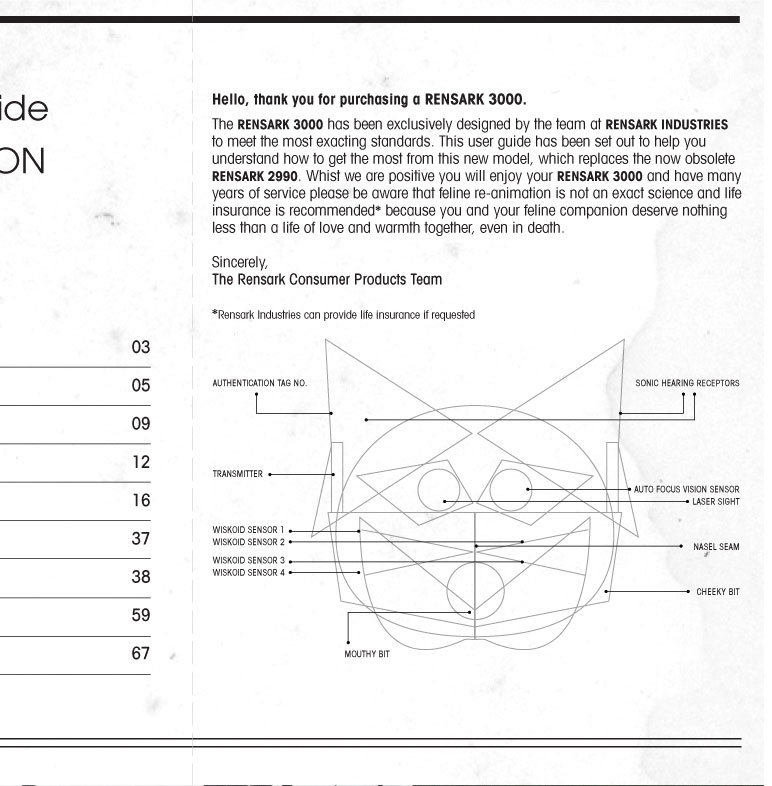
Detail from fold out exhibition guide
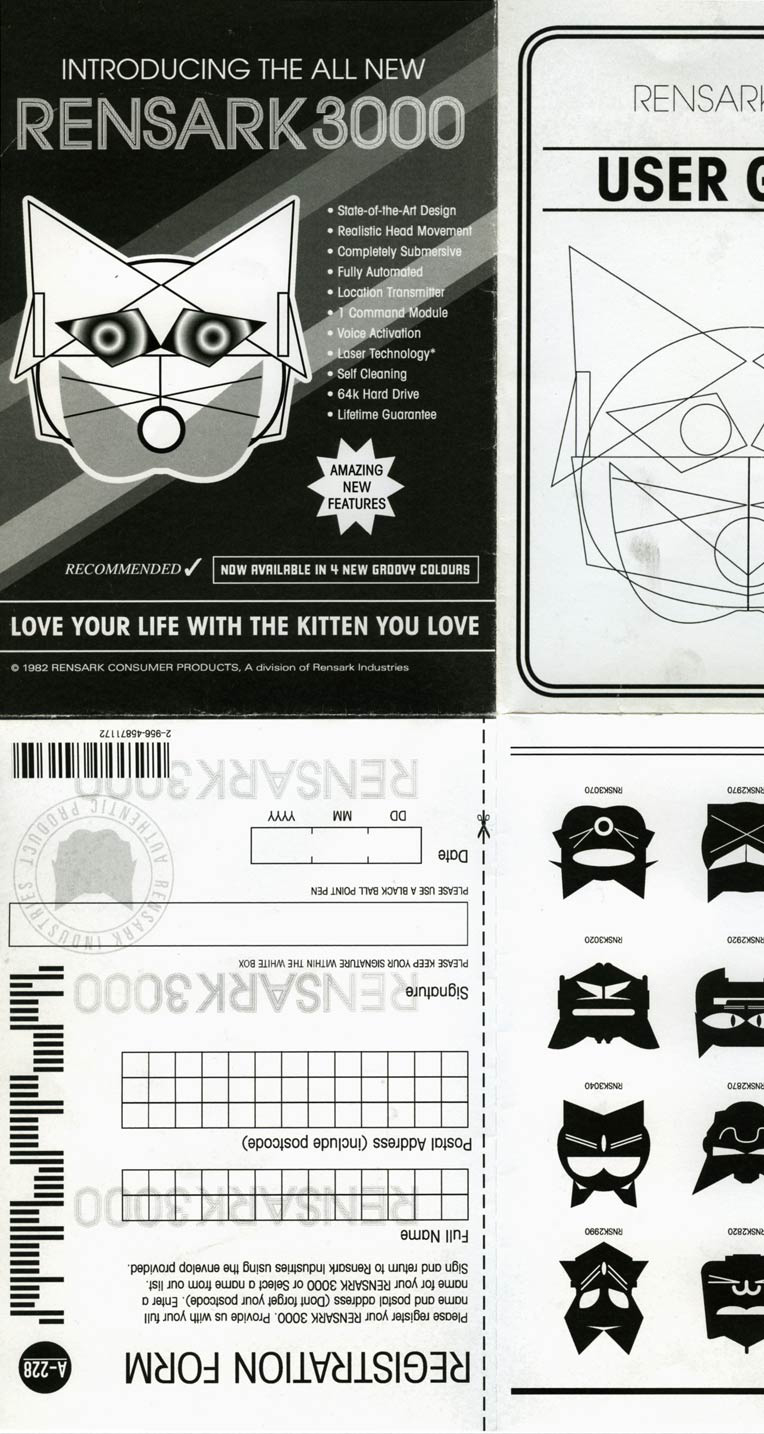
A3 digital prints from the exhibition.

User — digital print on archival paper

Luna Tunes Was The Name Of My Cat — digital print on archival paper
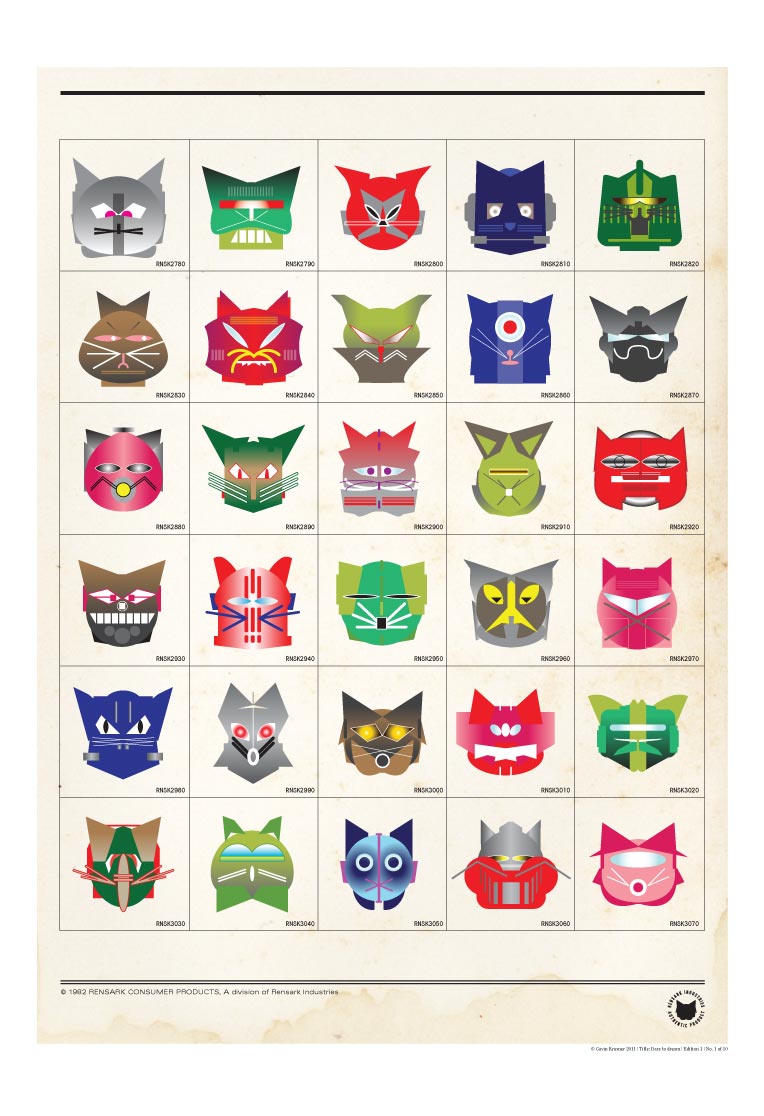
Dare to Dream — digital print on archival paper
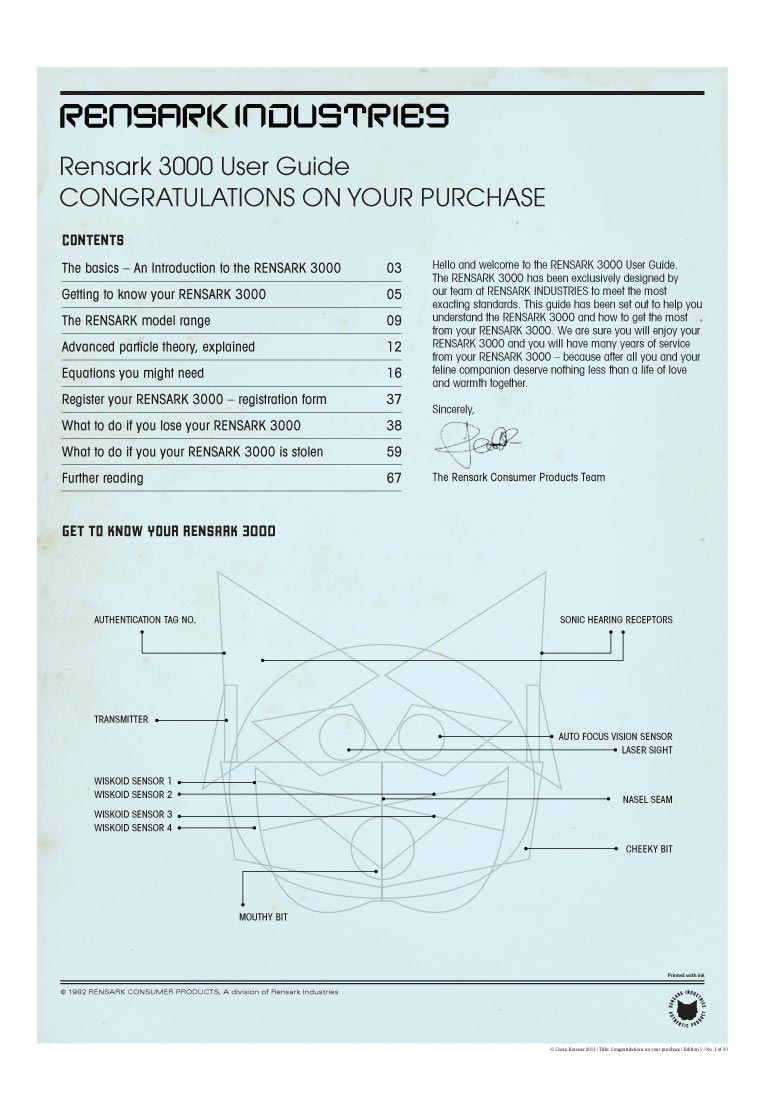
Congratulations On Your Purchase — digital print on archival paper
QAGOMA
BRISBANE CALLING
Every once in a while you experience something that inspires, invigorates and stirs the creative juices within.
A trip to Brisbane and in particular the Queensland Art Gallery / Gallery of Modern Art (QAGOMA) surpassed expectations, despite the threat of a cyclone to ruin the fun.
Cyclone Marcia was bearing down on the Queensland coast and playing havoc with flights* but it seemed that the cyclone would weaken sufficiently before it got any where near Brisbane so we decided to throw caution to the wind. And besides we were heading up for a friends’ wedding and the children were so looking forward to their grandmother babysitting.
*Well actually cyclone Marcia sadly devastated a number of towns including Yeppoon & Rockhampton but fortunately all Brisbane received was heavy rain and some minor flooding.
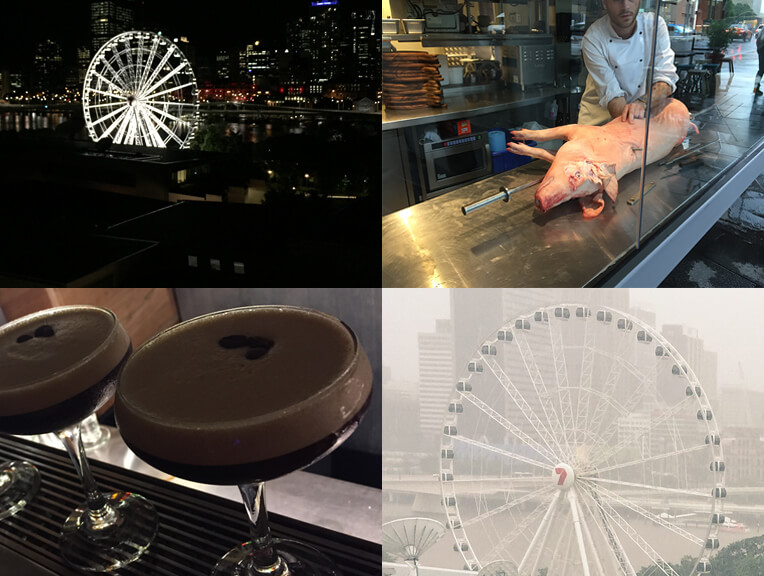
The night before, the day after — you know it’s going to be a great day when you see a pig being speared.
Having checked in to our hotel on the South Bank we hot footed it to the bar where we met our friends and several espresso martinis later and the weather was simply just a minor distraction. It had not rained all evening.
Saturday morning however was a different story, the rain was bucketing down. The wedding was not until 4pm meaning we had time to kill and we had planned to visit the QAGOMA a few blocks from our hotel. We still managed to get drenched but the need for coffee was strong and no rain would stop us.

Waiting for the rain to stop.
First coffee stop — view from the Queensland State Library cafe towards the Queensland Art Gallery. The entrance to the gallery is not particularly impressive but the first main hall you enter certainly is.
Sublime:
Contemporary works from the Collection

Columns | Zilvinas Kempinas, Lithuania b.1969 | 2006
Magnetic tape, painted wood panels and nails
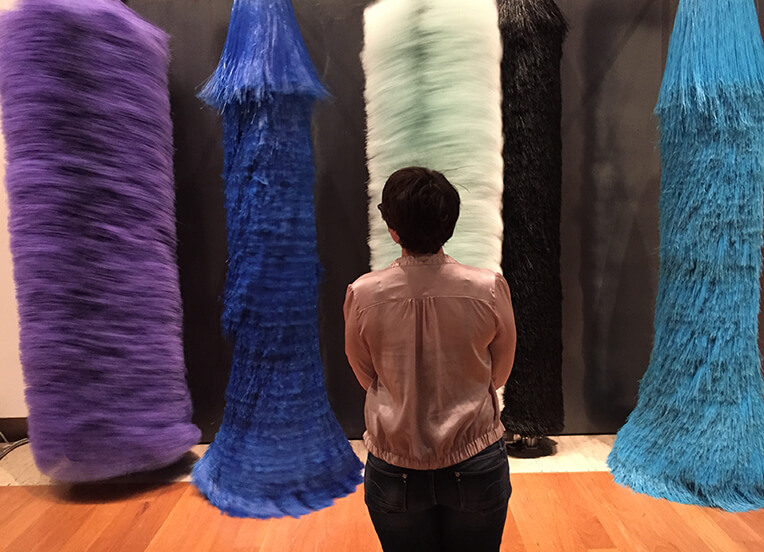
The Ex Mrs Chops contemplates life, art and is thinking this would be an ingenious way to wash the kids.

Dibirdibi Country | Mirdidingkingathi Juwarrnda | Sally Gabori, Kaiadilt people Australia b.c. 1924 | 2008
Synthetic polymer paint on linen. This work was so impressive set against the grey concrete walls with the water feature in front. The colours just pop.
Wandering around the galleries… the detailing on this work was exquisite.
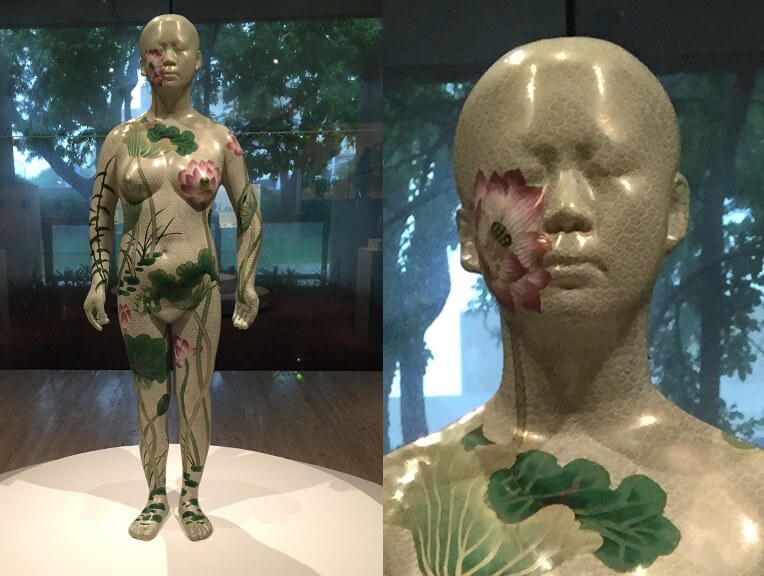
Human Human — lotus, cloisonné figure 1 | Ah Xian, China Australia b. 1960 | 2000-01
Hand beaten copper, finely enamelled in the cloisonné technique.

The Folly | Arlo Mountford, UK, Australia b. 1978 | 2007-09
3-channel digital animation with 4-channel audio
This was a 9 minute journey… subtle and strangely compelling as Mountford brings these 16th century Flemish masterpieces to life. The original paintings by Pieter Bruegel the Elder (c. 1525-69): The hunters in the snow, 1565, The Harvesters, 1565 and Landscape with the fall of Icarus c.1558 are set in motion with the action implied in each painting. Clever stuff.

Smart sits next to Brack… Jeffrey Smart’s “The Traveller” sits next to a stunning John Brack seated nude
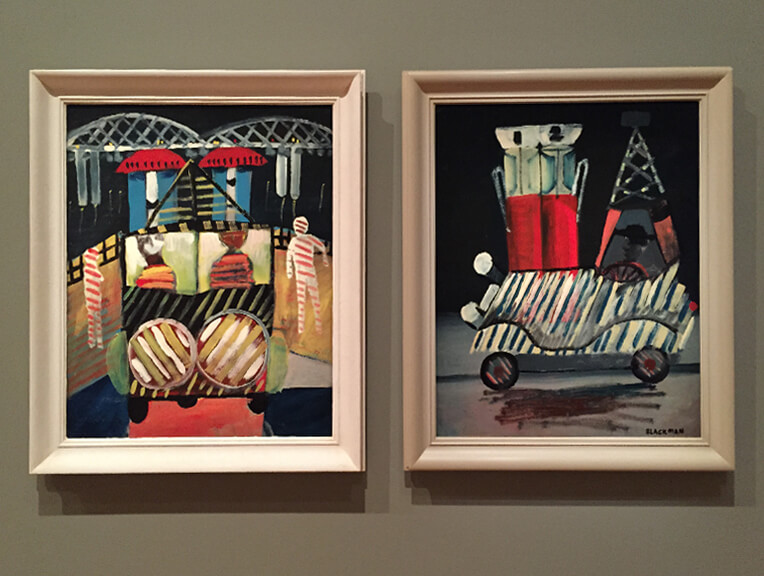
City lights 1952 | Barnes Auto, Brisbane | 1952 Charles Blackman, Australia b. 1928 | 1952
Both oil on composite board
HANGA: Modern Japanese prints. Details of just a few of the amazing screenprints that grabbed us.

Finger box | Ay-O, Japan b. 1931 | 1974 | from ‘Rainbow Landscape’ series | Screen print on paper

Details of 2 screen prints by Masami Teraoka, Japan/USA b. 1936
McDonald’s Hamburgers Invading Japan/Chôchin-me | 1982
Woman with Iris | 1980
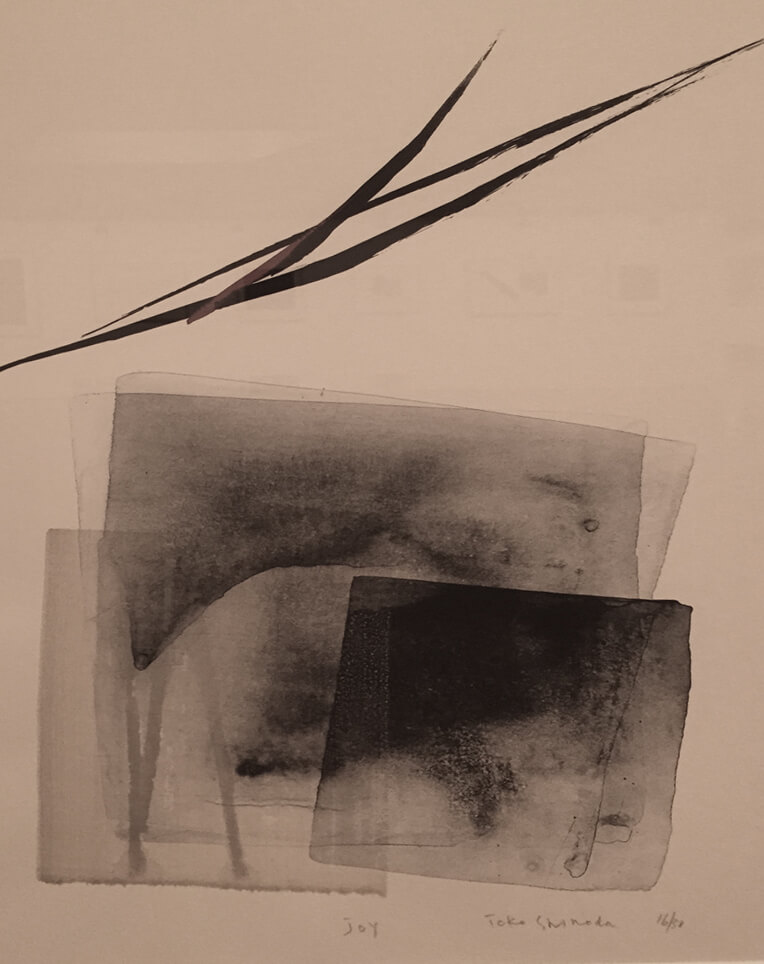
Joy | Toko Shinoda, Japan, b.1913 | 1992 | colour lithograph
Detail of my favourite screenprint by Tetsuro Sawada, Japan Untitled | 1983

And still the rain fell but the Brisbane art gallery really was the perfect way to spend a few hours. Even the rain was perfectly framed.
And Elizabeth’s favourite…
Henry Raeburn, Scotland 1756-1823, Portrait of Lady Campbell c.1795, Oil on canvas.

National Arboretum
FOREST OF DREAMS
What first strikes you about the National Arboretum is its distinct lack of trees. But don’t let that fool you. The National Arboretum is a most wonderful place to be and for Australian’s to be proud of.

Sitting a top of a prominent naked hill, sits “wide brown land”. On one level a truly impressive piece of typography — spelling out the description of Australia by Dorothea McKellar in her poem My Country — but on another level it beautifully captures the essence of Australia in a strikingly original way.
“Wide Brown Land” is made from corten steel and steel rod and is 3.5 metres high and 45 metres long and was created by Tasmanian-based artist team of Marcus Tatton, Futago Design Studios and Chris Viney in 2010 and is based on Dorothea McKellar’s handwriting. It really does delight the eye and one a a number of very impressive sculptures around the Arboretum.
If you are little person, the thing that will likely most catch your eye is the Pod playground.
Quite possibly the best playground in Australia? It’s like something out of a Tim Burton film set and executed with such wonderful attention to detail. #1 & #2 were positively enthused and trust me, they know a good playground when they see one. Award winning design by Taylor Cullity Lethlean The same guys behind the Australian Botanical Garden in Cranbourne.
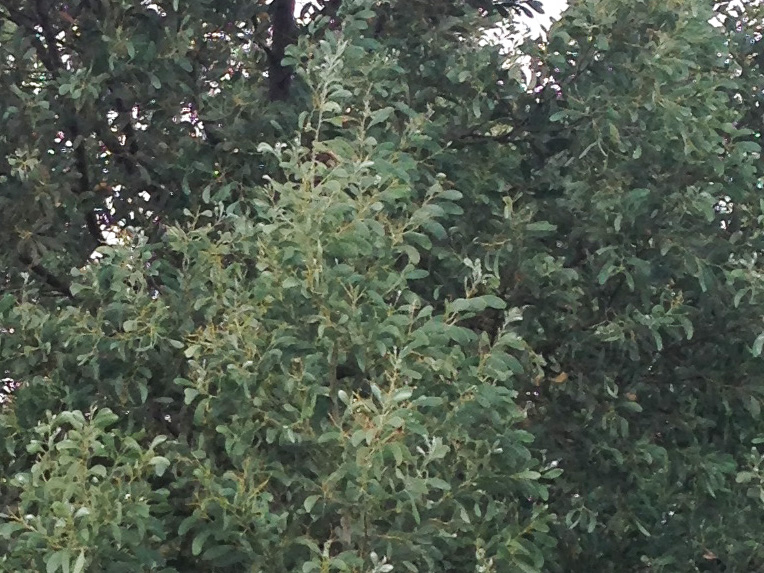
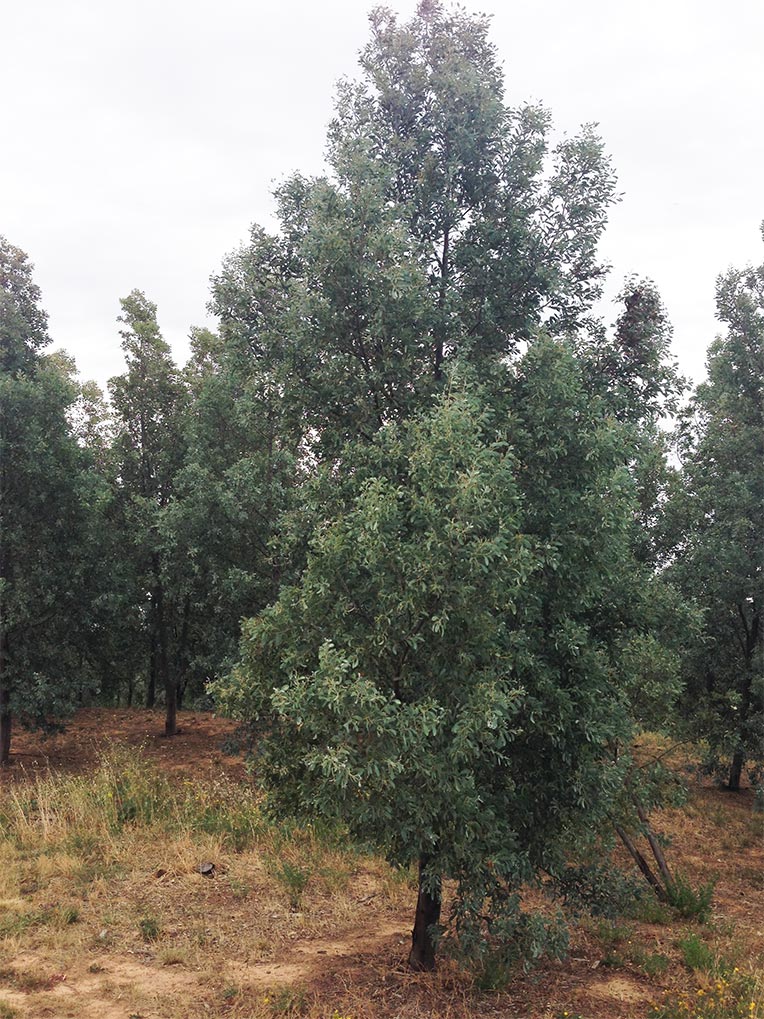



One notable absence at the Arboretum — no tree climbing area, to date…
And so the the main attractions — the trees, or lack of…
The Arboretum opened in February 2013, kick started by bush fires back in 2001 and 2003 (that effectively cleared the land) resulting in the government announcing the creation the 250 hectare (618 acre) site in 2004. However, a national arboretum was always a part of Walter Burley Griffin’s master plan for Canberra and four forests planted between 1917 – 1930 manged to survive the bush fires (Cork oaks —forest 1, Native trees and plantings — now Forest 2. Himalayan cedars — Forest 11, Monterey pines — Forest 76).
Of the more recently planted forests the Buchan Blue Wattle (forest 13) or Acacia caerulescens if you want the species caught my eye, chiefly because I have 2 of these rare trees in my back yard. They are quick growing, have a lovely pyramid shape, the foliage is dense and a splendid grey green. This species is endangered and only found growing in one small part of Victoria — near Buchan, hence the common name.
In time the 100 forests planned will be a truly magnificent site to behold and other forests that have been planted are beginning to take shape.
I can’t recommend a visit to the National Arboretum enough.
We were there on a very cool and unseasonably grey day at the start of January and we spent a good few hours wondering around. The bonsai garden will have little people captivated and the food offer at the village centre was great. But you can check out the highlights here.

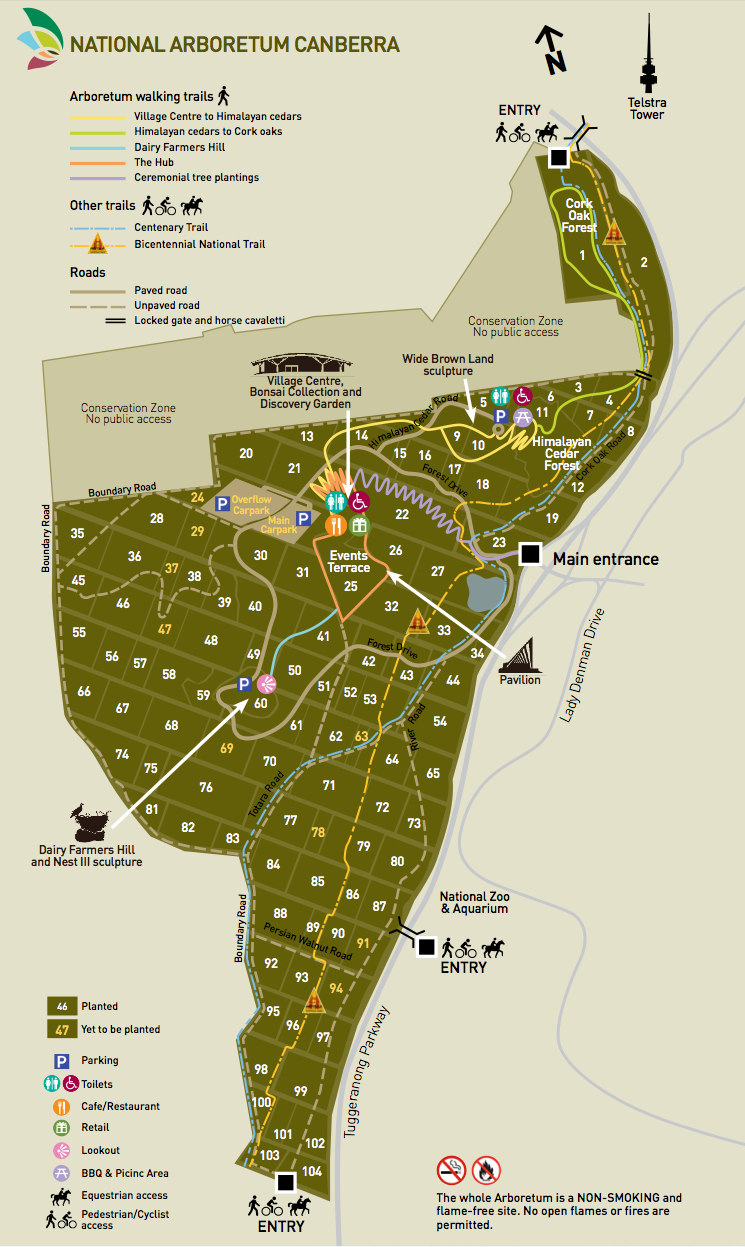
Zlutch, Zlaggard, Zander
A COLLECTIVE NOUN FOR ZUCCHINI
“Sir, when a man is tired of zucchini, he is tired of life; for there is in zucchini all that life can afford.”
It’s not widely known that Samuel Johnson, writer, poet, and lover of London Town was also a champion of the humble courgette (as it’s known in the UK).
It’s July and we’re still looking to reinvent and redefine the humble zucchini — nay even celebrate its modest yet versatile charms — I want to express my thoughts and love for this most abundant of garden growths.
Harvesting zucchini this year was great and nothing beats fresh from the garden, sliced and pan fried with a little olive oil, black paper and generous squeeze of lemon.
Dependable, lovable and surely one of the most satisfyingly easy fruits we grow in our backyard. The zucchini seems to get a raw deal when it comes to describing its general plentiful supply. Per plant (depending on variety and conditions) you can expect to yield between 12 and 30 fruit. Multiply this by three or four plants and I now understand why people in the past have laughed at me when I’ve told them that I’ve had five or six plants on the go.
Fortunately I love Zucchini, I even love saying the name.**
Imagine my dismay then to find that no definitive collective noun exists for zucchini. How can this be? Openly we talk about bushels of apples and bunches of coconuts, even hills of beans. But nowhere can I find a definitive reference for zucchini. Whilst I have seen ‘glut’ used on occasion it just seems a little too generic and in no way respectful.
So it’s with great excitement that I decided to create a collective noun for zucchini that will give a murder of crows a run for their money.
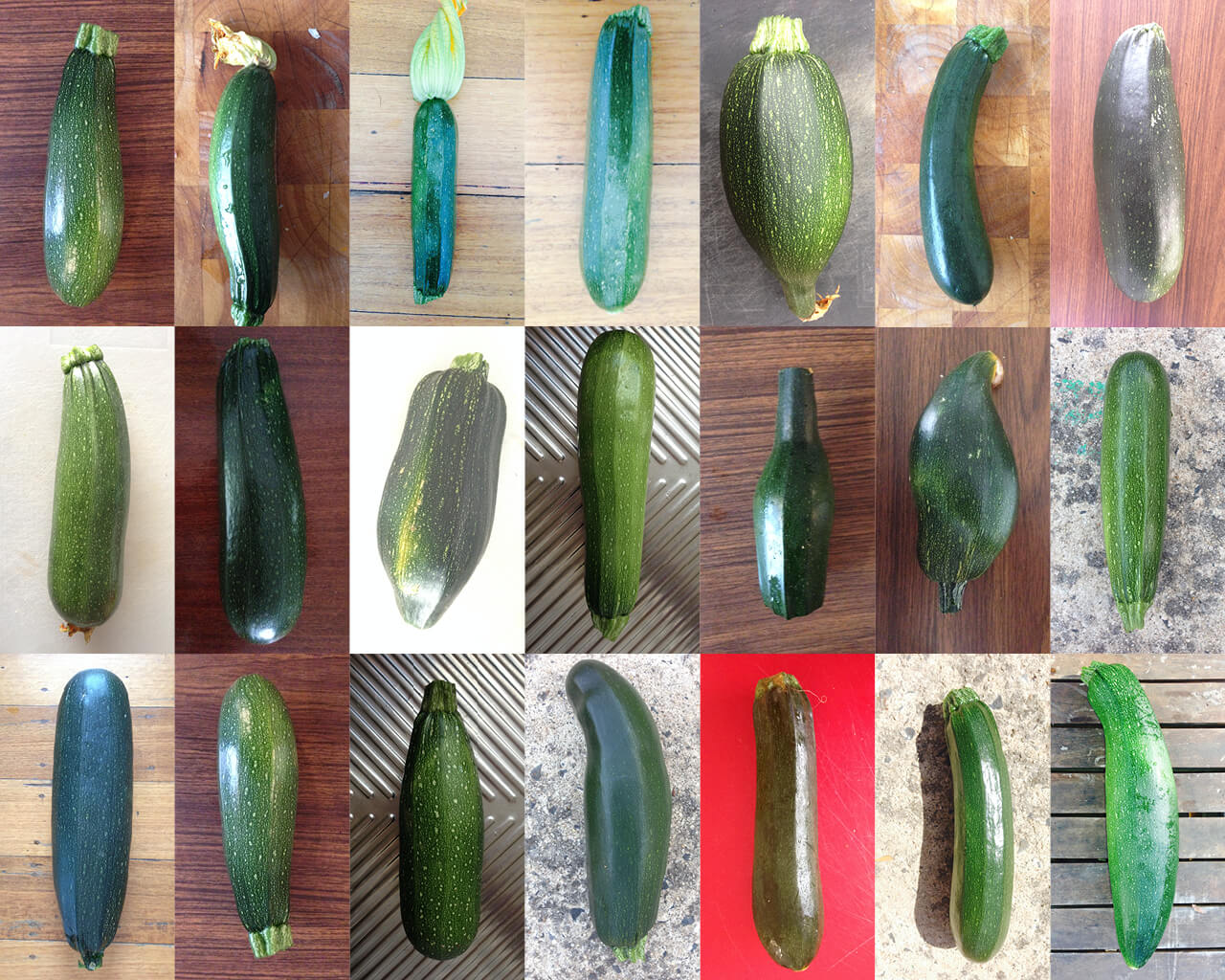 A catalogue of zucchini.
A catalogue of zucchini.
My desk based research has led me to discover such gems as a phalanx of umbrellas, a metamorphosis of ovoids and a goring of butchers but the best anyone has suggested (aside from a glut) was a zander of zucchuni although zander is also a type of fish.
So in establishing a collective noun what are the rules, if any? To understand the rules as such it’s important to understand the origins of how often witty and sometimes bizarre collective nouns arise.
The first collection in English appears in The Book of St Albans in 1486, an early printed work from a small press at St Albans, England. This three part book was about hawking, hunting and heraldry and is almost certainly a compilation of earlier works, probably written originally in French. The main things to glean from my reading is that most collective nouns appear to have been around for many years and are based on popular convention of the times. Many are poetic and even witty, especially those that are given to describe animals. Who doesn’t love a crossing of zebras or gaggle of geese.
But it seems less thought and wit has been given to fruit and veg perhaps until now. Recently I tweeted (yes it was a thing back then) my dismay and @Lorena_C (Lorena Carrington, super Castlemaine based photographer) replied with “a relentless army of” zucchini. I love it, it flows, it makes sense.”
“the relentless army of zucchini continues to march forth occupying vast strands of the vegetable patch…”
The best I’ve come up with so far is a zlutch or zlaggard, pronounced “zlag-ghard” (and spoken in pirate). But I wonder what other great terms may be out there that we can adopt? So at CFT_HQ we are running our first competition — with prizes and everything — for the best collective noun for zucchini. More details to follow.
The lemons are coming
MARMALADE IN THE MAKING
Finally! It only took 3 years but by golly we have our very own lemon marmalade this year!
One man’s obsession to grow lemons and make the good stuff.
They laughed, they said it couldn’t be done. Who’s laughing now my friends of Castlemaine…
It’s a common fact that basically it’s far too cold in Castlemaine to grow citrus effectively. But with a lots of love, encouragement and strategically placed pots miracles can happen.
Here’s how to make the best lemon marmalade in Castlemaine.
Method
Thinly slice your luscious lemons… the finer your slice, the more refined the cut.
Separate all the pips.
Wrap the pips in some muslin cloth (secure with some string) — the pips contain the most pectin and will help to set the marmalade — don’t leave any in the mix — no one likes crunching down on a hard pip.
Add the sugar and water, bring to a boil — use granulated sugar – NOT castor sugar.
Lower the temp and simmer away (gentle rolling bubbles) — the longer the cook, the darker the marmalade.
Setting
Stick a small plate in the freezer… after an hour or so you can start to test the viscosity of your marmalade, spoon a little onto the ‘frozen’ plate to see how well it will set… if it’s still runny, cook a little longer.
NOTE. if you really want a firm set add some jamsetta — personally I love a looser runnier set.
Best served on lightly toasted sourdough. Add unsalted butter for pure indulgence.
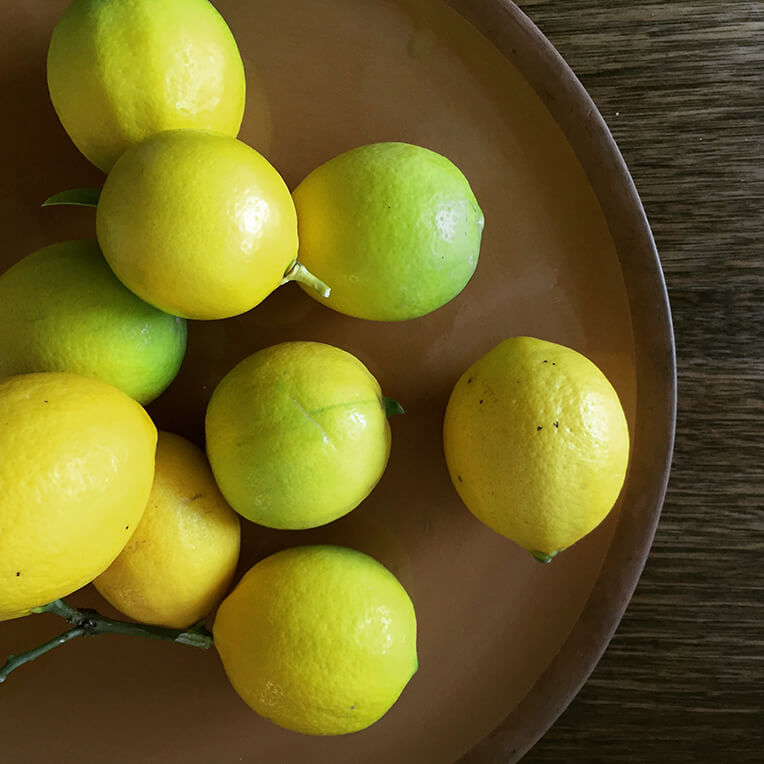
love love love
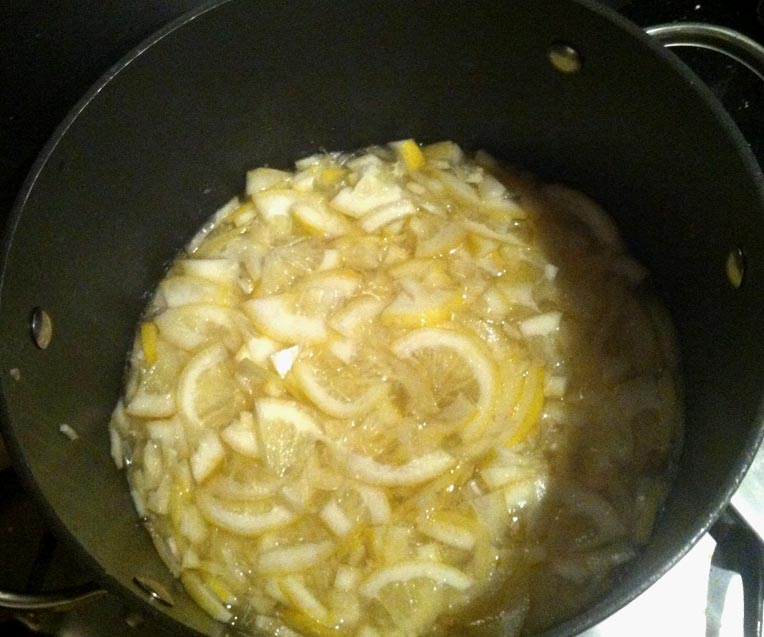
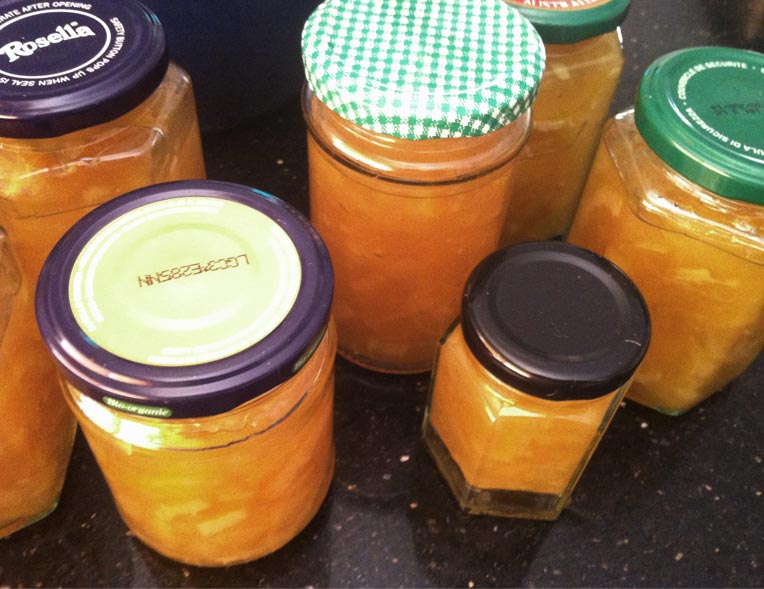
8 Myer Lemons
4 cups of water
4 cups of sugar
And 2 hours later…
Fig & Almond Cake
FIGGING GOOD
On an impulse I bought some figs. They just looked too good, sitting there, dumpy and just ripe.
And then I found a perfect sweet treat to bake. And it’s easy, texturally impressive and full of figgy goodness.

Ingredients
1 cup natural raw almonds (i.e. with husk)
1/4 cup of sugar (I used granulated plus 2 tbls for sprinkling)
1/4 cup of plain flour
1/2 tsp baking powder
1/8 tsp cinnamon
1/8 tsp salt
3 eggs (beaten)
2 tbls honey (I used awesome home produced home via friends in Barkers Creek — thanks Tony and Nico)
1/2 tsp almond extract
12-14 ripe figs
Method
Heat oven — 190ºC. Butter 9 inch fluted tart pan. Stick Almonds, the 1/4 cup of sugar in a process and whizz into a course powder. Add the flour, baking powder, cinnamon & salt. Pulse to combine. In a mixing bowl (or Kitchen Aid) whisk eggs, melted butter, honey & almond extract. Add the Almond mixture to this and beat for a minute until batter is just mixed.
Pour into the pan. And now for the figgy bit. Remove steams from figs and cut in half. Cut into quarters too. In fact get creative and lay your figs in the batter, figgy side up, how ever you please. Just cover the batter with figs. Then sprinkle the sugar over the top. That’s it.Stick it in the over for about 25-30 mins, until golden and dry in the centre (probe away). Awesome with home made vanilla ice cream.
Fun Fig Fact #1
Fig trees have no blossoms on their branches. The blossom is inside of the fruit! Many tiny flowers produce the crunchy little edible seeds that give figs their unique texture.
Rabbit for Tea
FROM PADDOCK TO PLATE
I’m not a big rabbit fan.
Well that’s not true, I love Bugs Bunny, Peter Rabbit and when I was growing up in London we had 19 very cute rabbits at one stage. And who doesn’t adore Welsh Rabbit? { That’s Welsh Rarebit Gavin! ~ Lizzie } But when it comes to eating rabbit I often shy away, until now…
For the 2nd year running, over the xmas break I have found myself on the back of a ute holding a 22 calibre rifle. The aim (forgive the pun) to bag a brace of wild rabbit and thus help with general pest control at Pine Vale, the Geddes family farm, some 3700 acres of wheat & sheep country located at Binya, NSW 30km due east of Griffith, approx 5 hrs north of Melbourne & 7hrs west of Sydney. So it’s cousin Joy that I have to thank for developing my taste for the old hoppity hoppity. Well actually it was the grandsons of Joy’s neighbours who have the whole rabbit shooting ute setup.
At first I was reluctant to go out shooting rabbit. Why?
I guess growing up in London rabbits are seen more as pets than food and I definitely wasn’t exposed to rifles and shooting stuff (fortunately) in the middle class suburbia I grew up in. So it just wasn’t in my veins – unlike most meat that I eat.
Arguably hunting animals for meat is what we’ve done for nearly 2 million years so whilst I haven’t been inclined to go kill a lamb, pig or cow, as this is conveniently done for me, a chance to eat what I’ve hunted down is quite refreshing. [insert moral debate Vegetarians Vs Carnivores] Once you have grappled with your conscious (meat lovers) it’s time to go get some dinner.

Being driven at speed across paddocks in the middle of a warm summer night is really quite exhilarating.
And when you add in a rifle slung over your shoulder… well I think they call it the thrill of the chase. Not that we are really chasing the rabbit, more searching the land with a high powered beam – looking for those eyes. Red eyes, not blues eyes. Remember: blue eyes = sheep. Very important not to hit the sheep seeing as they’re actually only there to be sold on. Oh and did I mention the foxes? Enemy number one to Mr & Mrs Chook and definitely not a friend to Mr. farmer.
We can be driving for 10 or 20 minutes in any direction but the guys know the best spots. Ashley & Blake grew up on the neighbouring farm and know the contours of this land like the backs of their hands. And these boys know guns too – shooting is most definitely in their veins. And then we spot ’em. We stop the ute. There are rabbits a plenty here. We take aim, we fire. It’s a challenge, a shot goes astray, it’s not easy picking out a rabbit as it turns and runs. And we aim for a clean shot to the head, it’s the quickest way and it also ensures the meat will be good. We bag a couple here, in fact by the end of the night we’ve shot seven rabbits in total and a number of foxes.
Once you accept that the rabbit you’re shooting is just part of life on the farm and it’s directly related to the farm’s survival the whole event takes on new meaning. This is a necessity but a tasty one. We get back to the farm house and Blake expertly guts and skins the rabbits. It’s 3 am, we sit back and drink a beer and think about how we’re going to cook our bunnies.
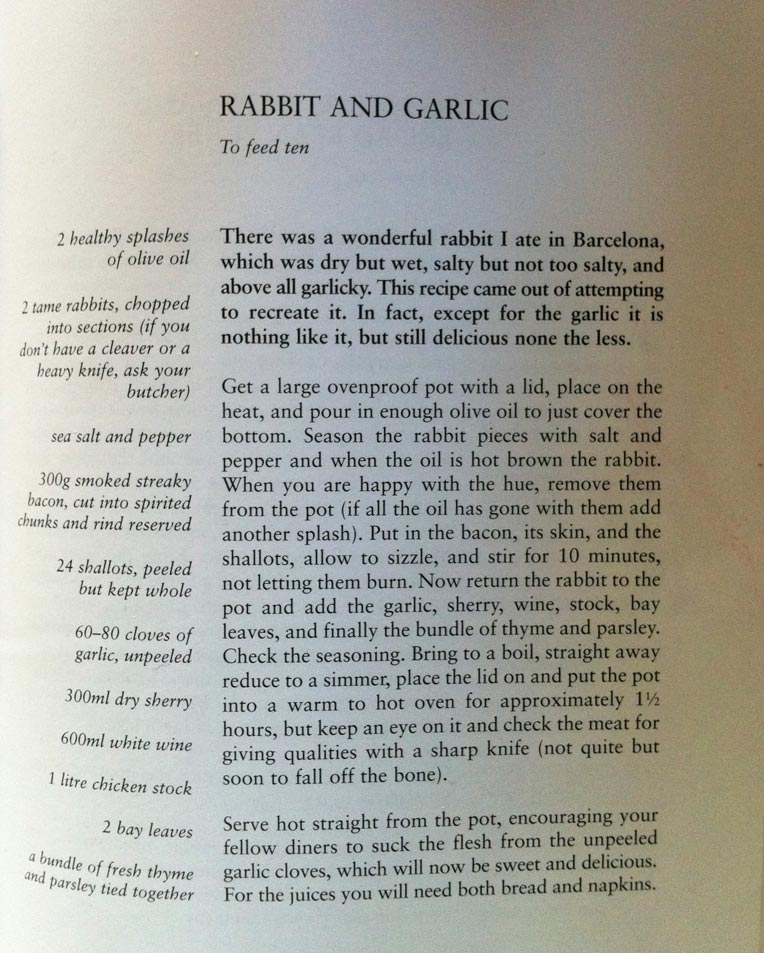
{ Is now the appropriate moment to reveal the fact I’ve been having vegan thoughts? ~ Lizzie }
The following morning we begin to prepare our rabbit feast.
I can’t lay claim to this recipe, we have Furgus Henderson to thank for this. He’s the chef of St. John restaurant in London and author of Nose To Tail Eating. Here’s how to enjoy your freshly killed rabbit, note we actually cooked our dish for about 3 hours on a lower heat. And the taste, well yes there’s lots of garlic there (80 cloves) but the white rabbit meat is strong and flavoursome and is soft and tender and to be honest not to far away from the taste of a chicken but with less fat and I’d thoroughly recommend it and even better if you know where your rabbit has come from.
